Online proceedings
*Notice: PDF files are protected by password, please input "ipop2010.6th". Thank you.
Thursday 10, June 2010
Opening
Thursday 10, June 2010 09:20-11:50
Chair: Naoaki Yamanaka, Keio University, Japan
Opening address
- Tomonori Aoyama, General Co-chair, Keio University, Japan
- Bijan Jabbari, General Co-chair, ISOCORE, USA
- Bijan Jabbari, General Co-chair, ISOCORE, USA
Keynote
Kou Miyake, NTT, Japan

Biography: Director of NTT Information Sharing Laboratory Group.
Dr. Kou Miyake received B.S. and M.S. degrees in mathematics in 1978 and 1980, and a Dr. Eng. degree on network performance analysis in 1991 from Tohoku University, Sendai, Japan, respectively.
Since joining the NTT Electrical Communication Laboratories in 1980, he has been active in network design and traffic engineering for satellite communications networks, packet-switched networks, and broadband communication networks. From 1998 to 2002, he had responsibility for the research and development of the Next Generation Network architecture and system engineering in NTT R&D Labs. From 2003 to 2007, he was the president of NTT Data Intelli-link Corporation, providing cutting-edge technologies to the telecommunication market. From 2007 to 2009, he was the director for NTT Service Integration Laboratories. Currently, he is
He had been an active participant in ITU-T Study Group 13 since 1990 as an expert on B-ISDN and ATM systems. Since 2000 to 2002, he was a board member of Multi-service switching Forum (MSF). He is a member of IEEE Senior member. He was awarded the Young Engineer Award from the IEICE in 1987.
Hans-Martin Foisel, Deutsche Telekom, Germany(OIF Carrier Working Group Chair and OIF President)
 Users want seamlessly connected advanced services delivered on-demand wherever they may be, on any platform, over any available network. But as the user experience becomes richer, the underlying technologies and networks become more complex. The OIF guides the development of building blocks for highly intelligent, reliable, interoperable networks that deliver enhanced services - all while meeting the challenges to simplify network operations and drive down costs. In this presentation you will learn about OIF work that helps meets these challenges. Get insights on work related to 100G, control plane as well as on-demand carrier services based on OIF implementation agreements.
Users want seamlessly connected advanced services delivered on-demand wherever they may be, on any platform, over any available network. But as the user experience becomes richer, the underlying technologies and networks become more complex. The OIF guides the development of building blocks for highly intelligent, reliable, interoperable networks that deliver enhanced services - all while meeting the challenges to simplify network operations and drive down costs. In this presentation you will learn about OIF work that helps meets these challenges. Get insights on work related to 100G, control plane as well as on-demand carrier services based on OIF implementation agreements.
Biography: Hans-Martin Foisel
Head of Hybrid Network Technologies, Deutsche Telekom OIF President and Carrier Working Group Chair
Hans-Martin Foisel joined Deutsche Telekom in 1998. He is currently Head of Hybrid Network Technology Department in the Technical Engineering Center at Deutsche Telekom Network Production. One of his main activity areas comprises control plane enabled networks, their architectures, functions, standardization and interoperability aspects. He joined the OIF in 1998, is chairing since 2002 the OIF Carrier Working Group and is currently the OIF President.
Prior joining Deutsche Telekom, he has worked at Heinrich-Hertz-Institute in Berlin for 19 years in the field of optical transmission systems research. He holds diploma of Electrical Engineering from the University Kassel and the Technical University Berlin, Germany.
Program introduction
- Monique Morrow, Cisco, USA and Eiji Oki, University of Electro-Communications, Japan
Exhibition introduction
- Kohei Shiomoto, NTT and Kosuke Nishimura, KDDI R&D, Japan
Technical Session
Tech. Session 1: Novel Applications and Services
Thursday 10, June 2010 13:10-14:50
Chair: Sugang Xu NiCT, Japan
Rie Hayashi, Kohei Shiomoto, NTT, Japan
 Introduction
GMPLS enables distributed network control by node itself, while it needs parameters such as IF addresses set in advance. We have proposed an optical plug and play (PnP) technique, and demonstrated it between OXCs [1]. It eliminates the need for setting lots of parameters manually, reduces operation labour and avoids configuration mistake. In this presentation, we demonstrate a PnP between a commercially available GMPLS router and an OXC as well as propose architecture requirements to realize a PnP in WDM networks including them.
Introduction
GMPLS enables distributed network control by node itself, while it needs parameters such as IF addresses set in advance. We have proposed an optical plug and play (PnP) technique, and demonstrated it between OXCs [1]. It eliminates the need for setting lots of parameters manually, reduces operation labour and avoids configuration mistake. In this presentation, we demonstrate a PnP between a commercially available GMPLS router and an OXC as well as propose architecture requirements to realize a PnP in WDM networks including them.
Network architecture for optical plug and play We assume that OXCs and routers are connected with WDM links via WDM systems. At least one wavelength in a WDM link is dedicated to an in-band control channel to exchange information necessary for PnP between adjacent nodes. Nodes need a function to assign address to IF automatically triggered by cable connection. Additionally, LMP (Link Management Protocol) should be supported to exchange assigned addresses between adjacent nodes. After the parameter exchange, configuration and databases necessary for network construction are automatically made. Moreover, OSPF-TE/RSVP-TE is necessary to establish paths after PnP. EO/OE converter is attached to OXCs, which we assume have no electrical function (i.e., 2R/3R, λ conversion) and only cross-connect function, to detect cable connection, while routers are always prepared for detecting link-up by sending signals.
Implementation We implemented our proposed PnP function in routers and OXCs in an optical network. Fig. 1 shows function blocks implemented in each node. There are routers, OXCs, and servers controlling nodes outside them. The server implements GMPLS protocol functions and others necessary for PnP. We utilized GMPLS Engine [2] as GMPLS functions in the servers. We implemented proposed PnP mechanism in a commercially available GMPLS router using SDK [3]. Three daemons dedicated to PnP were installed in the commercial GMPLS routers. These daemons make configuration, detects link-up event, and send/receive packets of protocol messages. Servers corporate and exchange information with PnP daemons in routers. For OSPF-TE and RSVP-TE, we utilized router’s functions. Since OXCs have only cross-connect function, servers belonging to OXCs play all of the roles necessary for PnP such as information management, address assignment, cross-connect set up, and GMPLS protocol functions.
Demonstration and evaluation We set routers and OXCs in our laboratory and constructed an optical network by PnP including link-up detection, addresses assignment and making configuration automatically. In the network, we evaluated required time to finish a link-up search. Additionally, numerical evaluations were made. In this presentation, we will report both demonstration and simulation results, and consider implementation issues.
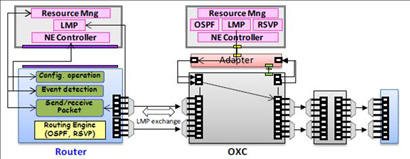
Fig. 1: Optical plug and play mechanism implementation.
Reference
[1] Kaori Shimizu, Rie Hayashi, Ichiro Inoue, and Kohei Shiomoto, P5.10, ECOC2009, Sept. 2009.
[2] http://shop.ntt-at.co.jp/gmpls/6gmpls/
[3] http://www.juniper.net/us/en/products-services/nos/junos/junos-sdk/
Biography: Rie Hayashi received the B.S. and M.S. degrees in Electronic Engineering from the University of Tokyo, Tokyo, Japan, in 2001 and 2003, respectively. In 2003, she joined NTT (Nippon Telegraph and Telephone Corp.) Network Service Systems Laboratories, where she has been engaging in research of multilayer traffic engineering techniques and flow-control methods. She is now researching control and management techniques for next-generation backbone network. She is a member of the IEICE.
Attila Takacs, Andras Kern, James Kempf, Howard Green, Elisa Bellagamba, Martin Johnsson, Ericsson, USA
 OpenFlow is an academic initiative to ease experimentation with and introduction of new control paradigms into production networks. The base OpenFlow specification is evolving rapidly driven by the active participation of universities, while also more-and-more industry players start to explore the capabilities of the technology. OpenFlow consists of (i) a simple flow based forwarding abstraction model, (ii) a configuration protocol between network elements and (iii) the OpenFlow Controller, and (iv) a virtualization layer that intrinsically isolates control and forwarding slices.
OpenFlow is an academic initiative to ease experimentation with and introduction of new control paradigms into production networks. The base OpenFlow specification is evolving rapidly driven by the active participation of universities, while also more-and-more industry players start to explore the capabilities of the technology. OpenFlow consists of (i) a simple flow based forwarding abstraction model, (ii) a configuration protocol between network elements and (iii) the OpenFlow Controller, and (iv) a virtualization layer that intrinsically isolates control and forwarding slices.
ASON/GMPLS is the standard, unified control plane architecture and protocol suit for connection management over various data plane technologies. GMPLS consists of a set of protocols: PCE/PCEP, OSPF/ISIS-TE, RSVP-TE and LMP; which together reduce manual configuration by automating provisioning, while still supporting centralized network management.
In our research we investigate the relations of the standard GMPLS control plane and the capabilities of the evolving OpenFlow architecture. We are experimenting with the OpenFlow technology by adding support for transport networking features, like control of MPLS forwarding, configuring protection switching, enabling/disabling OAM, etc.
This talk, besides comparing the components and operational principles of the two architectures, which are indeed very similar from one perspective, we also highlight key differentiators. We will then move on and discuss how OpenFlow may be extended to be a viable candidate to control transport networks and become a truly carrier-grade solution. Since our research activity is still in an early phase, we will conclude with preliminary findings and by scratching our future plans.
Biography: Attila Takacs is a research manager in Ericsson. He has been working with inter- and intra-domain traffic engineering, resource management, and cross-layer optimization for media delivery systems. At present, his focus is on packet transport technologies and related GMPLS control plane aspects, he is active in IETF standardization. He has a Master's degree in computer science and a post-graduate degree in banking informatics both from the Budapest University of Technology and Economics.
Rajiv Papneja, Bijan Jabbari, ISOCORE, USA
 As bandwidth demand for novel services continues to grow and to meet carriers’ expectations vendors have rolled out new features and enhanced their existing MPLS based solutions to the next level of sophistication and portfolio richness. With the wide acceptance of MPLS as the key enabler its role has been expanding beyond the core and edge to the transport and packet core for next generation mobile services. Additionally, carriers are actively migrating their revenue bearing multicast services onto their MPLS based infrastructure. All these developments have led to competitive end-to-end solutions offerings from vendors for meeting the ever demanding customer expectations for highly resilient and reliable service delivery.
As bandwidth demand for novel services continues to grow and to meet carriers’ expectations vendors have rolled out new features and enhanced their existing MPLS based solutions to the next level of sophistication and portfolio richness. With the wide acceptance of MPLS as the key enabler its role has been expanding beyond the core and edge to the transport and packet core for next generation mobile services. Additionally, carriers are actively migrating their revenue bearing multicast services onto their MPLS based infrastructure. All these developments have led to competitive end-to-end solutions offerings from vendors for meeting the ever demanding customer expectations for highly resilient and reliable service delivery.
This presentation aims to discuss the progress made to date on the stability of these new features and the increase in the level of interoperability amongst the MPLS/IP vendors. The talk will share the key observations from the various testing efforts carried out in the areas of MPLS applicability to fixed, mobile and transport (MPLS-TP) networks. The session will offer an insight to the audience and provide an overview of the lab environment that is created to validate these services in small to large-scale network settings.
Biography: Rajiv Papneja is a seasoned technology leader with extensive experience in advanced high-speed networking and telecommunications. His experience has been in the areas of network architecture analysis, protocol viability, system analysis, stability, and performance verification of telecom products and solutions. He is an active contributor in various standards development organizations. Rajiv has co-authored a several of Internet standards, technical briefings, reports, and presentations. His contributions so far have been in the fields of networking protocol extensions, implementation clarifications, performance benchmarking, network migration strategies and analysis of optical and packet transport, wireless and wireline networks. He is extremely adroit in the areas of Carrier Ethernet, provider backbone bridging, mobile backhaul, Long Term Evolution (LTE), Triple Play and IPTV architectures, MPLS, IPv6, IPv4 routing protocols L2/L3 VPNs, Ethernet OAM, High Availability (HA) and transport technologies such as GMPLS and MPLS-TP. Rajiv earned his M.S (Electrical Engineering) with honors from George Mason University, Virginia, USA and he is currently with Isocore as a Director of technology validation and product verification.
Meng Lu, Yaohui Jin,Yingdi Yu, Weiqiang Sun, Wei Guo, Weisheng Hu, Bin Zhu, Xueqing Wei, Shanghai Jiao Tong University, China
 Introduction
The GMPLS provides an intelligent control plane for different types of transport networks, and extensible features such as bandwidth modification, various recovery mechanism, and point-to-multipoint connections, which also increase the complexity of implementation and the difficulty of evaluation. Simulators are economical and valuable tools to develop, test and diagnose the GMPLS protocols. Previous efforts included extensions to general network simulators NS-2[1] and OPNET [2], and specific simulator, e.g. GLASS by NIST [3]. It is well known, however, the network simulators have their own limitations. First, simulation results are usually not those produced by real hardware and software equipment. Second, these simulators are not extensible to support new features. Network emulation [4] and field trial [5] could partially solve the high-fidelity issues, however large amount of hardware equipments and development resources are required. To alleviate the above drawbacks, we present Big-TNet, an extensible and high-fidelity GMPLS emulator for the control plane of large scale transport networks.
Introduction
The GMPLS provides an intelligent control plane for different types of transport networks, and extensible features such as bandwidth modification, various recovery mechanism, and point-to-multipoint connections, which also increase the complexity of implementation and the difficulty of evaluation. Simulators are economical and valuable tools to develop, test and diagnose the GMPLS protocols. Previous efforts included extensions to general network simulators NS-2[1] and OPNET [2], and specific simulator, e.g. GLASS by NIST [3]. It is well known, however, the network simulators have their own limitations. First, simulation results are usually not those produced by real hardware and software equipment. Second, these simulators are not extensible to support new features. Network emulation [4] and field trial [5] could partially solve the high-fidelity issues, however large amount of hardware equipments and development resources are required. To alleviate the above drawbacks, we present Big-TNet, an extensible and high-fidelity GMPLS emulator for the control plane of large scale transport networks.
Extensible and Flexible The thinking of inheritance and polymorphism in the object-oriented approach is imported into the Big-TNet. Taking the advantage of that, our Big-TNet enables users to configure functions of Label Switch Router (LSR), for example, label allocating and flooding policies, during the running time or based on eXtensible Markup Language (XML) files. The users can also easily extend the features of Big-TNet by overriding the existing code. For example, we have constructed the extensions for Ethernet by adding only one hundred lines code based on the existing Big-TNet code for SDH.
High-fidelity and Light-weight The Big-TNet is high-fidelity, in the sense that it can correctly reflect network’s behaviors under different configurations, for that it fully complies with the standard MPLS/GMPLS MIB’s (Fig.1) and the protocol processing flow specified by IETF. So it could interwork with the real control plane. To evaluate large-scale network, we integrate many LSR’s in one computer and omit the processing of protocol stacks. In our experiment the number of LSRs in one personal computer can reach to 50. In order to verify the correctness of the protocol flow, all the message sequences can be exported to a file and analyzed offline by Wireshark (Fig.2).

Case Study: Multi Layer and Multi Domain Network With the benefit of the Big-TNet, we have developed a demonstration incorporating with PCE, VNTM to explore the integrated control and management architecture of multi-layer and multi-domain network (Fig.3). In the near future, we are going to deliver the Big-TNet source code for research use and application.
RefAcknowledgement: This work was supported by China 973, 863 and NSFC programs.
Reference
1. The Network Simulator - ns-2,http://www.isi.edu/nsnam/ns/
2. OPNET, http://www.opnet.com/solutions/index.html
3. NIST-GLASS Webpage, http://snad.ncsl.nist.gov/glass/
4. Y. Iizawa, et al., “An Evaluation of Scalability of PCE-based Routing Model in Multi-Domain GMPLS Networks”, iPoP 2009, paper 6-2
5. J. Wang, Y. Jin, et al., “Field Trial of Inter-Domain Point-to-Multipoint Connections in ASON Using Web Service Mechanism”, OFC 2007, paper OMJ3
Biography: Meng Lu is a Graduate student in the Department of Electronic Engineering of Shanghai Jiao Tong University (SJTU), China. She received her B.S. named "goutstanding graduate" at SJTU in 2008, and will receive her M.S. from the same university in 2011. Her research interests include Multi-domain routing and signaling, large-scale network emulation.
Poster Session
@Exhibition room
Thursday 10, June 2010 15:05-16:20
P-1
"Dependable Resource Management Scheme for Mixed-Rate WSON Using Wavelength-Grouped Transmission-Guaranteed Link "
Yoshiaki Sone, Akihiro Kadohata, Akira Hirano, Atsushi Watanabe, NTT, Japan
 This study presents a network resource management scheme that considers the optical reach of light paths for Wavelength Switched Optical Networks
(WSONs) [1][2], especially for WSONs that provide multiple bit rates of light paths. WSONs are expected to reduce the cost of optical backbone
networks that employ wavelength switching elements. This is because wavelength switching not only reduces the number of required expensive
electrical regenerators, but also easily enables comprehensive operation of multiple rates for optical paths on the same infrastructure. In this study, we
particularly focus on a WSON that has the following three aspects: 1) multiple bit rates of optical paths (mixed-rate WSON), 2) regenerators that are
sparsely equipped (Translucent WSON), and 3) a transmission system designed so that the optical reach of the optical paths is guaranteed only for the
practically necessary route in order to reduce the transmission system cost.
This study presents a network resource management scheme that considers the optical reach of light paths for Wavelength Switched Optical Networks
(WSONs) [1][2], especially for WSONs that provide multiple bit rates of light paths. WSONs are expected to reduce the cost of optical backbone
networks that employ wavelength switching elements. This is because wavelength switching not only reduces the number of required expensive
electrical regenerators, but also easily enables comprehensive operation of multiple rates for optical paths on the same infrastructure. In this study, we
particularly focus on a WSON that has the following three aspects: 1) multiple bit rates of optical paths (mixed-rate WSON), 2) regenerators that are
sparsely equipped (Translucent WSON), and 3) a transmission system designed so that the optical reach of the optical paths is guaranteed only for the
practically necessary route in order to reduce the transmission system cost.
The challenge to WSON is the management of network resources considering the transmission reach. One reason for this is the wavelength continuity constraint of the wavelength routing. Another reason is limited route selectivity in providing a route for the optical path because of the limitation of the optical reach. In mixed-rate WSONs in particular, the optical reach may differ according to the bit rate; therefore, handling the optical reach is more difficult. These have been the issues facing resource management in providing intuitive resource information to operators at the time of path provisioning, since some resources may not be actually available due to the limitation of the optical reach. In other words, the resource information without considering the optical reach is not dependable.
As one possible solution to this problem, we proposed a novel resource management scheme that employs the Wavelength-Grouped Transmission-Guaranteed Link (λTGL) (Fig. 1) [3]. The λTGL is an end-to-end virtual link pre-established on the control plane between the source and destination of a potential optical path route. The λTGL is defined only for the route where the optical reach is guaranteed. Along the end-to-end route of this λTGL the control plane manages the following resource information.
- The available wavelength indices considering wavelength continuity constraints along the end-to-end routes
- The available amount of resources, i.e. number of wavelengths, considering the number of available regenerators along the end-to-end routes
In addition, the λTGL is established for each bit rate independently. Since the transmission reach and available type of regenerators may differ according to the bit rate of the optical path, the available λTGL should be different for each bit rate (Fig. 2). This λTGL provides a dependable resource management scheme that can manage the available amount of resources considering the optical reach limitation according to the bit rate of the optical path.
This presentation analyzes the implementation method of the λTGL that can be applied to Mixed-rate WSONs assuming the generalized multi-protocol label switching (GMPLS) [4] extension and describes the requirements for the protocol function.
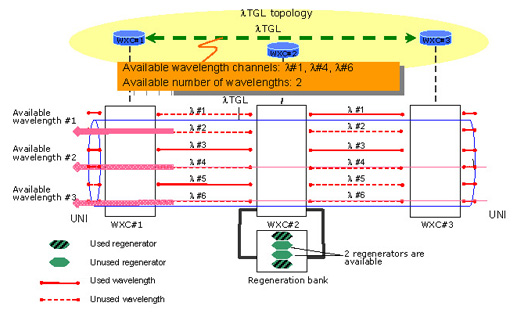
Fig. 1: Overview of λTGL (without wavelength conversion)
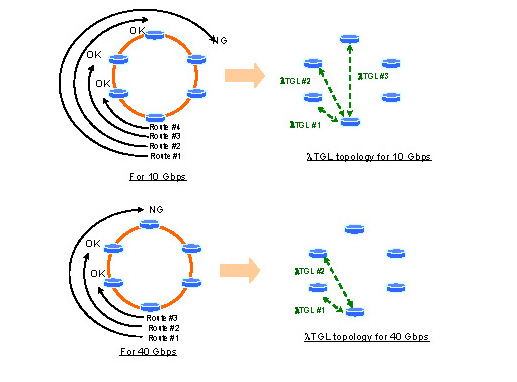
Fig. 2: Resource management for mixed-rate WSON
Reference
[1] G. Bernstein et al., ”draft-ietf-ccamp-rwa-wsonframework-04.txt”, 2009.
[2] http://www.grotto-networking.com/taxonomy/term/4.
[3] Y. Sone, et. al,ECOC, P5.14, 2009.
[4] IETF RFC 3945.
Biography: Yoshiaki Sone received his B.E. and M.E. degrees in electronics engineering from Tohoku University, Sendai, Japan, in 2001 and 2003 respectively. In 2003, he joined the NTT Network Innovation Laboratories and has been engaged in research on control technology of photonic transport networks. His research interest lies in network architecture, resilience schemes, designs of protocols for distributed control such as ASON/GMPLS, and interoperability testing of such protocols. He is a member of the Institute of Electronics, Information, and Communication Engineers (IEICE) of Japan.
P-2
"Carrier Wavelength Reusable Multicarrier Distributed WDM Ring Network Using Optical Drop-Add-Drop Multiplexers"
Motoharu Matsuura, Eiji Oki, The University of Electro-Communications, Japan
 This paper presents a multicarrier distributed wavelength-division-multiplexing (WDM) ring
network based on reconfigurable optical “drop-add-drop” multiplexers and carrier wavelength reuse for
regional/metro networks. In conventional reconfigurable optical add/drop multiplexer (ROADM) network
in Fig. 1(a), multiple laser-diodes (LDs) are distributed in each edge node (EN), while in our previously
proposed multicarrier distributed network in Fig. 1(b), optical carriers generated by a centralized
multicarrier light source (MCLS) are “dropped” at ENs and used for uplink transmission. Data are
“added” to the network by external modulation of one or more carriers. Data are then “dropped” at the
destination nodes. The ROADM is not only used to “add” and “drop” data, but also to “drop” carriers,
which is called “drop-add-drop” and eliminates many distributed LDs used in the conventional network.
This paper presents a multicarrier distributed wavelength-division-multiplexing (WDM) ring
network based on reconfigurable optical “drop-add-drop” multiplexers and carrier wavelength reuse for
regional/metro networks. In conventional reconfigurable optical add/drop multiplexer (ROADM) network
in Fig. 1(a), multiple laser-diodes (LDs) are distributed in each edge node (EN), while in our previously
proposed multicarrier distributed network in Fig. 1(b), optical carriers generated by a centralized
multicarrier light source (MCLS) are “dropped” at ENs and used for uplink transmission. Data are
“added” to the network by external modulation of one or more carriers. Data are then “dropped” at the
destination nodes. The ROADM is not only used to “add” and “drop” data, but also to “drop” carriers,
which is called “drop-add-drop” and eliminates many distributed LDs used in the conventional network.
In this work, we successfully demonstrate a proposed “drop-add-drop” network experiment offering 10 Gbit/s WDM transmission. Moreover, to dramatically improve the utilization efficiency of the carrier wavelengths distributed by the MCLS in the proposed network, we introduce the carrier wavelength reuse technique which sets an all-optical carrier extraction (ACE) circuits in each EN as shown in the inset of Fig. 1(b). This technique reuses the carrier wavelengths that were already utilized for data transmission between prior source and destination nodes. In Fig. 1(b), the transmitted data and carriers are “dropped” by a wavelength selective switch (WSS). The “dropped” data are split by the optical coupler. The output of one port is detected at the receiver (Rx), while that of the other port data is injected into the ACE through the WSS. After passing through the ACE, the regenerated carriers are combined with the dropped carriers by the ROADM. Some of these carriers are modulated by the external modulator (mod), as needed, and injected to the network by the final coupler. Moreover, to evaluate the effect of carrier wavelength reuse, we compare the blocking probabilities of the proposed networks with and without carrier wavelength reuse. In addition, we numerically analyze the advantages of the “drop-add-drop” network over the conventional ROADM network in terms of network cost and power consumption.
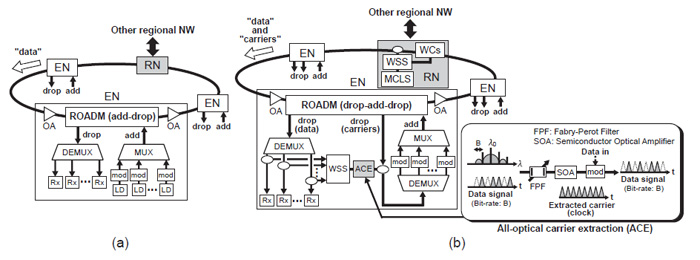
Fig. 1: (a) Conventional ROADM network with multiple distributed LDs.
(b) Proposed “drop-add-drop”network with a centralized MCLS and distributed ACE
in each EN. Inset shows schematic view of ACE.
Biography: Motoharu Matsuura received the B.E., M.E., and Ph. D. degrees in electrical engineering from the University of Electro-Communications, Tokyo, Japan, in 1997, 1999, and 2004, respectively. In 2004, he joined the Department of Electronic Engineering at the University of Electro-Communications as a postdoctoral fellow and became an assistant professor in April 2007. Currently, he is a tenure track assistant professor of the same university. He has been researching single-frequency fiber laser, all-optical signal processing using SOA and fiber, photonic network, and Radio-over-Fiber (RoF) systems. He received the Ericsson Young Scientist Award in 2008 and FUNAI Information Technology Award for Young Researcher in 2009. He is a member of the IEICE, IEEE, and OSA.
Shota Yamada, Jumpei Marukawa, Daisuke Ishii, Satoru Okamoto, Naoaki Yamanaka, Keio University, Japan
 With the appearance of the cloud network, high speed data communication among data centers is necessary. However, because the data is transmitted through the Internet, network bandwidth is not enough. To construct large bandwidth WAN at low cost, we propose an Intelligent Cloud Network. Fig.1 shows basic concept of the Intelligent Cloud Network. In the Intelligent Cloud Network, data delivered with parallel transmission and lower cost private lines that are lower bandwidth are applied as multiple routes. In this paper, we propose parallel transmission system. In this system, parallel routes are set up with GMPLS. Under the GMPLS environment, OSPF is used on the control plane. Every node in proposal environment can realize the network topology in order to advertise and exchange the route information to each other. In the proposed system, OSPF is used to discover the multi-path between two TCP over SCTP adaption gateways and RSVP plays a role to establish parallel routes between two gateways. The proposed system is implemented on the software switch, as shown in Figure2, and end-to-end throughput is evaluated.
With the appearance of the cloud network, high speed data communication among data centers is necessary. However, because the data is transmitted through the Internet, network bandwidth is not enough. To construct large bandwidth WAN at low cost, we propose an Intelligent Cloud Network. Fig.1 shows basic concept of the Intelligent Cloud Network. In the Intelligent Cloud Network, data delivered with parallel transmission and lower cost private lines that are lower bandwidth are applied as multiple routes. In this paper, we propose parallel transmission system. In this system, parallel routes are set up with GMPLS. Under the GMPLS environment, OSPF is used on the control plane. Every node in proposal environment can realize the network topology in order to advertise and exchange the route information to each other. In the proposed system, OSPF is used to discover the multi-path between two TCP over SCTP adaption gateways and RSVP plays a role to establish parallel routes between two gateways. The proposed system is implemented on the software switch, as shown in Figure2, and end-to-end throughput is evaluated.
Acknowledgement: This work is partially supported by “Lambda Access” Project funded by the National Institute of Information and Communication Technology (NICT).
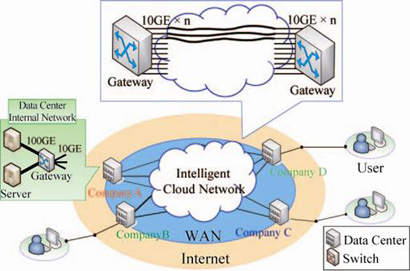
Fig. 1: A basic concept of the intelligent cloud network
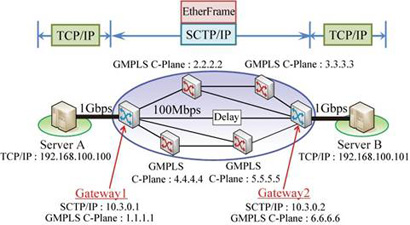
Fig. 2: Experimental system.
Biography:
Shota Yamada was born in Kanagawa, Japan on January 8, 1987. He received B.S degrees from Department of Information and Computer Science, Keio University Science and Technology, Tokyo, Japan, in 2005 and 2009. Then he is admitted Communication and Media Technologies, Graduate School of Keio University, Tokyo, Japan, in 2009. His current research interest is parallel transmission systems.
Benoit Tremblay, Andras Kern, Ericsson, USA
 Using a common control plane for the different technologies of a transport network has been perceived by many operators and service providers as a good way to better manage their network and to increase the coordination between the different layers both for resource usage and resiliency.
Using a common control plane for the different technologies of a transport network has been perceived by many operators and service providers as a good way to better manage their network and to increase the coordination between the different layers both for resource usage and resiliency.
Recent work in IETF CCAMP working group and OIF has proposed extensions to routing and signaling protocols to manage connections in a multi-technology network using a single GMPLS control plane instance. These proposed extensions are pretty stable and at Ericsson we felt that it was time to implement an experimental test-bed to validate these extensions and to provide feedback to the work in progress in the different standardization bodies.
The test-bed, showcasing a small network with commercial MPLS and WSON nodes, demonstrates multi-layer path computation, multi-technology signaling, and multi-layer protection coordination. The test-bed provided the opportunity to study the impact of the proposed extensions on the different components of GMPLS.
During our experimentation, we faced some issues to describe interfaces implementing multi-layer encapsulation. The GMPLS way of specifying the encapsulation uses a simple model - a switching type and an encoding field - that impacts the capability to properly represent such interfaces. It results sometimes in inappropriate path computations: e.g., selecting non-compatible interfaces as Forwarding Adjacency endpoints. We implemented some routing extensions, that we called technology adaptation capability descriptor, to include additional information in the link capability description to further detail the interface encapsulation capability.
In this presentation, we will describe the test-bed and present some key results from the experimentations.
Biography: Benoit Tremblay collaborates with Ericsson for more than 10 years. He has been involved in developing distributed servers for mobile networks. He joined Ericsson Research in 2002 where he focused on establishing experimental systems for the IP edge, access and broadband networks. He graduated in Mathematics with specialization in Computer Science from the Universite du Quebec a Montreal in 1986 and completed a Master Degree in 1988. His current topics of interest are broadband network and packet systems.
Eunyoung Cho, Sunme Kim, Wonkyung Lee, Hoyoung Song, Jehoon Yoo, Taewhan Yoo, ETRI, Korea
 Markets for POTS are growing for OPEX and CAPEX advantages including hardware enhancement and intelligent provisioning technology. This paper presents experiment with packet-optical layer integrated management and connection path control in the POINTS (Packet-Optical Integrated Network Transport System). The POINTS provides a combined packet/optical transport plane. Therefore, both PBB-TE and ROADM network transmission services are available in one box. It also communicates with PCE via IETF RFC 5440 PCEP for on-demand PTL/OTL path computation. For P2P permanent and soft-permanent connection, POINTS interacts with MONCP (Multi-layer Optical Network Control Platform) optimized path provisioning. This presentation includes our test results, lessons and how to achieve the fast prototyping for management plane, GMPLS-based control plane, forwarding and data plane using public domain products and industry-academy cooperation. As a future work, we have a plan to upgrade for resiliency and join the interoperability testbed.
Markets for POTS are growing for OPEX and CAPEX advantages including hardware enhancement and intelligent provisioning technology. This paper presents experiment with packet-optical layer integrated management and connection path control in the POINTS (Packet-Optical Integrated Network Transport System). The POINTS provides a combined packet/optical transport plane. Therefore, both PBB-TE and ROADM network transmission services are available in one box. It also communicates with PCE via IETF RFC 5440 PCEP for on-demand PTL/OTL path computation. For P2P permanent and soft-permanent connection, POINTS interacts with MONCP (Multi-layer Optical Network Control Platform) optimized path provisioning. This presentation includes our test results, lessons and how to achieve the fast prototyping for management plane, GMPLS-based control plane, forwarding and data plane using public domain products and industry-academy cooperation. As a future work, we have a plan to upgrade for resiliency and join the interoperability testbed.
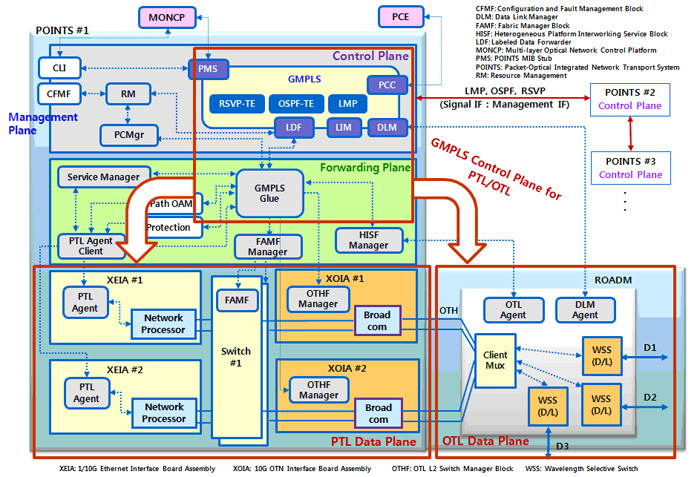
Fig. 1: Management and Control Plane Components for PTL/OTL Path Connection
Biography: Eunyoung Cho is a principal member of technical staff in Optical Internet Research Department at ETRI, Korea. Ms. Cho graduated from Ewha Womans University in 1986, and received MS degrees from KAIST and Carnegie Mellon University in 1997 and 2007, respectively. Since 1986, she has been involved in several large research projects on broadband network system such as SDH, WDM and PBT transmission funded by the Korean government. She has experience of development work on both management system and several transport systems in convergence network. Currently, she interests the cooperative operation and manageability in control plane and management plane for intelligent multi-layer transport system network for future network.
John E Drake, Juniper, USA
This presentation will describe the features in the latest version of G.709 and how they will be supported by the GMPLS control plane. It will also describe how GMPLS can be used, in conjunction with the Path Computation Element, to optimize a next generation transport network with respect to resource utilization and provisioning responsiveness. Such a next generation network can be characterized as a network that provides high bandwidth packet and circuit services over a transport layer consisting of WDM spans, integrated switching elements, and Ethernet framing.
P-7
"Achieving Nanosecond Switching Time for Intra-Data-Center Connectivity - The Omnipresent Ethernet Approach"
Ashwin Gumaste, Indian Institute of Technology, India
 Intra data center connectivity has received significant attention in recent times, thanks to the importance in achieving
scale of server blades in meeting the ever increasing data needs. Much work has been devoted recently in defining
the architecture that interconnects server blades within the data center. The interconnection architecture is important
as it determines the latency between an external access to the data center and the corresponding response (in terms
of information flow) from the data center. The architecture is a key enabler in the future development of the data
center into a services infrastructure platform. In this regard it is desired to create an interconnection architecture that
helps in achieving low-latency between server blades. A study of data center architectures leads to three structural
issues that form the key assumptions of our proposal: (1) the interconnection requires hierarchy of Ethernet
switches; (2) The data center is well shielded from the rest of the network through a single (or at times two-for
redundancy) connection point(s); the presence of hierarchical interconnection switches and a single or at the most
two points of presence to the rest of the Internet imply that the data center architecture can be abstracted to a tree.
Using the aforementioned observations it is possible to create a new architecture that leads to nanosecond class
switching between server blades. Two approaches are
presented - (1) using technology that is backward
compatible with Ethernet - and called Omnipresent
Ethernet (proposed by us in [1]) and (2) using a
proprietary frame format that is valid for intra-data
center connectivity and leads to <50ns inter-switch
latency. Essentially both the approaches are
successful in significantly reducing latency, while
enabling a better connected intra data center
infrastructure.
Intra data center connectivity has received significant attention in recent times, thanks to the importance in achieving
scale of server blades in meeting the ever increasing data needs. Much work has been devoted recently in defining
the architecture that interconnects server blades within the data center. The interconnection architecture is important
as it determines the latency between an external access to the data center and the corresponding response (in terms
of information flow) from the data center. The architecture is a key enabler in the future development of the data
center into a services infrastructure platform. In this regard it is desired to create an interconnection architecture that
helps in achieving low-latency between server blades. A study of data center architectures leads to three structural
issues that form the key assumptions of our proposal: (1) the interconnection requires hierarchy of Ethernet
switches; (2) The data center is well shielded from the rest of the network through a single (or at times two-for
redundancy) connection point(s); the presence of hierarchical interconnection switches and a single or at the most
two points of presence to the rest of the Internet imply that the data center architecture can be abstracted to a tree.
Using the aforementioned observations it is possible to create a new architecture that leads to nanosecond class
switching between server blades. Two approaches are
presented - (1) using technology that is backward
compatible with Ethernet - and called Omnipresent
Ethernet (proposed by us in [1]) and (2) using a
proprietary frame format that is valid for intra-data
center connectivity and leads to <50ns inter-switch
latency. Essentially both the approaches are
successful in significantly reducing latency, while
enabling a better connected intra data center
infrastructure.
The Omnipresent Ethernet Approach: The concept involves converting any abstract tree to a binary tree - by the addition of “dummy” nodes so as to smoothen out all the nodes that each have a 1x2 interconnection pattern (see [1] for details). A binary tree leads to binary routing - i.e. the facilitation of source routing - with binary addresses - a bit in which tells a node whether to go left or right in a 1x2 switch. A node only has to process a single bit at a 1x2 switch or 2log2N bits for an NxN switch, without the need for any lookup or endto- end access. Each node is assumed to have its address - a binary value that determines its route from the root of the binary tree - the POP that interconnects the data center to the rest of the network. For communication, nodes embed their source address (the binary string from the root to the source - and called Source ARTAG), the binary string to the destination - called Route ARTAG) as VLANs in a Carrier Ethernet frame (with STP, MAC learning switched off. A node en route to the destination only selects the appropriate R-ARTAG frame and works on those bits within the R-ARTAG that are of importance to it. The new Ethernet frame with the SARTAG and RARTAG is shown in the adjacent figure, while preliminary results that compare the OEthernet concept to data centers is shown in the figure above. A second Ethernet frame with only SFD byte and ARTAG is also possible as the entire communication is within the data center - resulting in few nanosecond latency.
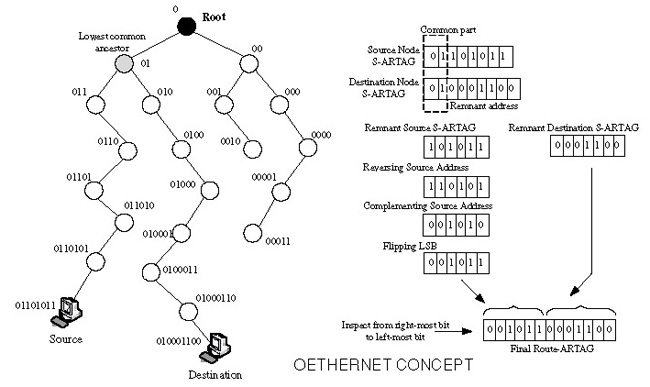
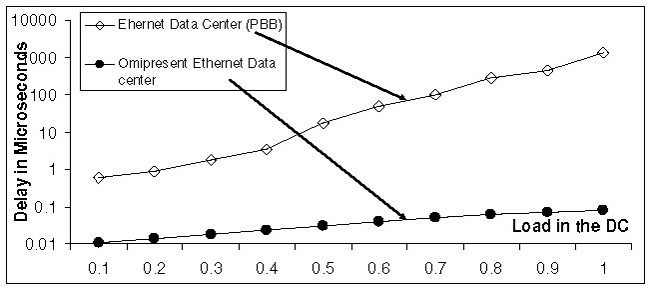

Reference
[1] A. Gumaste, S. Mehta, I. Arora, P. Goyal, S. Rana and N. Ghani, "Omnipresent Ethernet: Design Choices and Technology Drivers for
Future Internet, " accepted and to appear IEEE Journal of Lightwave Technology, JLT, 2010.
[2] S. Mehta, R. Vaishampayan and Ashwin Gumaste, "Omnipresent Ethernet: A Novel Metro Communication System using Binary + Source
Routing and Carrier Ethernet," Post Deadline Paper, 25th IEEE OSA Optic Fiber Communications (OFC) conference, 2009, San Diego, USA,
March 2009.
Biography: Ashwin Gumaste is currently a faculty in the Department of Computer Science and Engineering at the Indian Institute of Technology Bombay. At IIT Bombay, he holds the James R. Isaac Chair. He was a Visiting Scientist with Massachusetts Institute of Technology (MIT), Cambridge, USA in the Research Laboratory for Electronics - Claude-E-Shannon group from 2007 to 2009. He was previously with Fujitsu Laboratories (USA) Inc as a Member of Research Staff in the Photonics Networking Laboratory (2001-05). He has also worked in Fujitsu Network Communications R&D and prior to that with Cisco Systems in the Optical Networking Group (ONG). His work on light-trails has been widely referred, deployed and recognized by both industry and academia. He has 17 granted US patents and has over 30 pending patent applications. Ashwin has published about 120 papers in referred conferences and journals. He has also authored three books in broadband networks called DWDM Network Designs and Engineering Solutions (a networking bestseller), First-Mile Access Networks and Enabling Technologies and Broadband Services: User Needs, Business Models and Technologies for John Wiley. He has served Program Chair, Co-chair, Publicity chair and workshop chair for IEEE conferences and as Program Committee member for IEEE ICC, Globecom, OFC, ICCCN, Gridnets etc. Ashwin is also a guest editor for IEEE Communications Magazine, IEEE Network and the founding Editor of the IEEE ComSoc ONTC’s newsletter Prism. He is the Secretary of the IEEE Communication Society's Technical Committee on High Speed Networks (TCHSN). He has been with IIT Bombay since 2005 where he convenes the Gigabit Networking Laboratory: www.cse.iitb.ac.in/gnl
Elisa Bellagamba, Loa Andersson, Ericsson, USA
 This presentation describes the MPLS OAM architecture. It addresses issues around OAM functionality for all type of LSPs, regardless of how they have been established.
This presentation describes the MPLS OAM architecture. It addresses issues around OAM functionality for all type of LSPs, regardless of how they have been established.
The MPLS-TP project has produced (will produce) specifications that extend the MPLS OAM capabilities and indicate how OAM messages are transported over the MPLS data plane, how nodes behave when they receive OAM messages and the structure of the OAM messages themselves.
The joint project between IETF and ITU-T has put a focus on the OAM functionality needed for the Transport Profile for MPLS. There are clearly a new set of functionality required when introducing the Transport Profile for MPLS. MPLS on the other hand has an extensive list of OAM functions that will still be in use also when the Transport Profile is completed. The MPLS OAM Framework [RFC4378] gives an overview of the MPLS OAM scenario.
Due to the number of new OAM tools provided by the MPLS-TP project it is easy to get the impression that all the MPLS OAM tools comes from the MPLS-TP project; this is not the case MPLS has a long history of OAM, e.g. LSP Ping and VCCV. This presentation describes the entire MPLS OAM Architecture regardless of where the OAM functions and tools has originated.
From the point of view of the IETF and the MPLS technology there is no real difference between an RFC developed solely by an IETF working group and an RFC developed in the MPLS-TP project. Documents from both sources contribute a single MPLS technology. Every RFC that is part of the MPLS technology needs to be compatible with the rest of the technology.
This backwards compatibility is equally relevant for the OAM functionality specified by the MPLS-TP project. Everything in the OAM specified in the MPLS-TP project is backwards compatible with the MPLS technology as it is specified by the IETF prior to the MPLS-TP project.
Biography: Elisa Bellagamba received her MSc degree in Computer Science Engineering in 2006 from Pisa University, Italy. In 2007 she joined Ericsson R&D laboratory in Pisa, working on the implementation of GMPLS for optical networks. She has been working for Ericsson Research in Stockholm since 2008 where her topics of interest are broadband networks and packet systems. Since 2009 she has been actively contributing in IETF within MPLS and CCAMP working groups.
P-9
"OOO/Optical Packet Switching Applications in Cloud/Net Computing, and Post LTE Wireless Networks - Scalability, Performance, and Enablers"
Vasile Radoaca, Alcatel-Lucent, USA
Cloud Computing and beyond it, Net Computing is coming as the new big thing for the next decade, at the cross roads of emerging new technology trends in the Computing technology, Software and Network Virtualization, Optical transmissions, new emerging business trends and practices in the Enterprise and Consumer Market, and a new model of services revenue.
Post LTE or the 5th generation Wireless networks, is becoming an important research area, covering Wireless, backhauling, Cloud Computing/Virtual Telco, and Content Delivery, that we will allow to deliver new type of services, with high throughput, performance, and high quality of experience.
Both Cloud Computing and Post LTE network need new fundamental technologies, enablers and key building blocks that will allows applications to scale, increase the performance and quality of services, while the power consumption will be reduce by a least one order of magnitude.
The paper explores, the new breakthrough in the optical technologies, in special on OOO/MPLS-TP packet switching, 100 Gb, that we will allow to implement in a very efficient and performance way, both Cloud/Net Computing and Post LTE type networks.
Biography: Vasile Radoaca has joined Alcatel, in 2006 as CTO for the Optical Network Division, APAC, as one of the key expert in the Ethernet, Layer 2/3, MPLS, and Optical Transport technologies, with a long and established record in the Telecom industry, and standard organizations IETF, IEEE, ITU, and OMG.
Within 15 years proven experience in the Telecom industry, Vasile Radoaca played important roles in developing key technologies for Ethernet, VPLS ,Provider Bridge Backbone, and Network Management.
During his carrier, Vasile Radoaca was directly involved in all the aspects of the product development cycle, as Chief Architect, Senior Product Manager, and CTO, being engaged in service/platform architecture, software embedded, standardization process, marketing and customers engagement.
As an active member of the IETF/IEEE organizations, Vasile Radoaca has published directly or co-authoring more that 15 drafts (with 7 RFCs) being one of the pioneer for the MPLS Applicability in the carrier space - MPLS Pseudo wire (Martini PW), L2VPNs, VPLS-GVPLS, Service emulation and inter-operability.
Vasile Radoaca holds a Master Degree in the Computer Science.
Guanjun Gao, Jie Zhang, Wanyi Gu, Beijing University of Posts and Telecommunications, China
 Transparent wavelength switched optical networks (WSON) can lower the capital expenditure (CAPEX) and
operating expenditure (OPEX) considerably by eliminating some expensive electronic regenerators and introducing
intelligence in the control plane (CP), which on the other hand, may also cause unacceptable lightpath Quality of
Transmission (QoT) deteriorations as the result of dynamic lighpath configuration. In order to guarantee the
acceptable QoT, the physical layer impairments (PLI) awareness has been introduced into CP through
Impairment-Aware Routing and Wavelength Assignment (IA-RWA) [1-5]. However, most of the studies on
IA-RWA [1-5] are based on the assumption of fixed physical layer, i.e., the physical layer parameter (e.g. amplifier
gain, pre- and post-dispersion compensation, attenuation, etc.) can not be tuned dynamically. Traditionally, the
universal deployed tunable devices can’t be aware of the working states of each other and thus only tuning
separately by local monitoring. This may result in disordered and unnecessary states adjustment along the lightpath,
which will cause large time delay, transients and increasing OPEX of operators [6].
Transparent wavelength switched optical networks (WSON) can lower the capital expenditure (CAPEX) and
operating expenditure (OPEX) considerably by eliminating some expensive electronic regenerators and introducing
intelligence in the control plane (CP), which on the other hand, may also cause unacceptable lightpath Quality of
Transmission (QoT) deteriorations as the result of dynamic lighpath configuration. In order to guarantee the
acceptable QoT, the physical layer impairments (PLI) awareness has been introduced into CP through
Impairment-Aware Routing and Wavelength Assignment (IA-RWA) [1-5]. However, most of the studies on
IA-RWA [1-5] are based on the assumption of fixed physical layer, i.e., the physical layer parameter (e.g. amplifier
gain, pre- and post-dispersion compensation, attenuation, etc.) can not be tuned dynamically. Traditionally, the
universal deployed tunable devices can’t be aware of the working states of each other and thus only tuning
separately by local monitoring. This may result in disordered and unnecessary states adjustment along the lightpath,
which will cause large time delay, transients and increasing OPEX of operators [6].
To overcome the shortcomings mentioned above, we have proposed the basic idea of dynamic QoT optimization by incorporation of extended CP and tunable devices [7, 8]. Here we will review the progress on the Impairment Controllable WSON (IC-WSON) including the aspects of (i) architecture and protocol designs, (ii) physical layer modelling and (iii) QoT optimization. Two novel QoT optimization schemes (Q-allowable, Q-best) will be proposed with analytical and numerical comparisons. Experimental demonstration of IC-WSON will also be presented based on the AMSON testbed [9].
Reference
[1] B. Ramamurthy, et al., JLT, vol. 17, no.10, pp. 1713-1723 (1999).
[2] Annalisa Morea,et al., JON, vol.7, no.1, pp.42-61 (2008).
[3] R. Martinez, et al., IEEE Communications Magazine 44 (12) pp.76-85, (2006).
[4] Pablo Pavon-Marino, et al., JLT, vol 7, No.12, pp.1763-1775. (2009)
[5] J. He, et al., IEEE GLOBECOM 2007, pp. 2269-2274.
[6] L. Zong, et al., OFC/NFOEC 2008, paper JWA117.
[7] Hua Zhang et al., JON, Vol. 7, No.6, pp.573-584 (2008).
[8] Guanjun Gao, et al., OECC 2009, paper ThB2.
[9] Xuping Cao, et al. ECOC 2009, paper P5.13.
Biography: Guanjun Gao is currently a Ph.D candidate in Institute of Information Photonics and Optical Communications in Beijing University of Posts and Telecommunications (BUPT), China. His focus is on the analytical modeling of optical transmission impairments, impairment-aware and impairment-controllable optical networks designs, and advanced modulation formats and systems.
Weiqiang Sun, Yaohui Jin, Wei Guo and Weisheng Hu, Shanghai Jiao Tong University, China
 GMPLS at a glance
Generalized Multiprotocol Label Switching, or GMPLS, is a suite of protocols to enable automated resource discovery, automated service provisioning and automated failure recovery. Driven by the benefit of improved network reliability (through protection or fast failure recovery) and reduced network OPEX, an increasing amount of GMPLS enabled networks are now being deployed in metro area and even in national backbones. In the short run, the deployment of such networks will enable network operators to provide new value added services such as Bandwidth on Demand (BoD) with a reduced OPEX. In the long run, GMPLS networks have the potential of carrying a big variety of services. In this article we try to highlight the current status in the research community and challenges for such a trend.
GMPLS at a glance
Generalized Multiprotocol Label Switching, or GMPLS, is a suite of protocols to enable automated resource discovery, automated service provisioning and automated failure recovery. Driven by the benefit of improved network reliability (through protection or fast failure recovery) and reduced network OPEX, an increasing amount of GMPLS enabled networks are now being deployed in metro area and even in national backbones. In the short run, the deployment of such networks will enable network operators to provide new value added services such as Bandwidth on Demand (BoD) with a reduced OPEX. In the long run, GMPLS networks have the potential of carrying a big variety of services. In this article we try to highlight the current status in the research community and challenges for such a trend.
Examples of applying GMPLS for novel services Starting from 2001, the time when the key concepts and features are gradually being standardized, a considerable number of efforts have been seen in the area of putting GMPLS into advanced networking/service environments. This is exemplified by the various research programs in the US, Europe and Asia (see [1] and [2] for an overview). In such programs, GMPLS has not only been used as a way to reduce management complexity and increase reliability, like the industry is doing right now, but also it is used as a new way for service provisioning. For example, the GMPLS control plane is often integrated with the application to realize seamless on-demand circuit provisioning, so that dynamic data intensive applications may be served with dedicated bandwidth pipes in an efficient manner. In a more recent effort, Vincent W. S. Chan et al. argue that GMPLS can be one of the enabling technologies for realizing large scale dynamic wavelength services to the masses [3]. By combining statistical multiplexing in access networks and GMPLS provisioned quasi-static light-paths in core networks, the researchers claim that future all optical networks may be able to serve up to 107 users in a metro area network (MAN), each at a data rate that a wavelength can provide.
In another work, W. Sun et al. demonstrated cross-layer circuit provisioning to satisfy different application needs [2]. An application, instead of an end system as a whole, can be the entity to request a light-path. In the demonstration, the initiation of light-path setup is seamlessly integrated with the TCP 3-way handshake process, resulting in a high performance yet transparent transmission service. When implemented in a private network, this way of circuit provisioning may be an interesting candidate for future demanding applications, data center inter-connection being one of them.
Dynamic provisioning performance of GMPLS Before GMPLS can be fully utilized to its potential, it is important that we have good ways to characterize and measure its performance. What seem obvious performance measures include LSP dynamic provisioning performance, failure recover performance, singling and routing scalability etc. What seems less obvious is the consistency between control plane and data plane. Standardization on some of these performance measures has started [4-7] and still has a long way to go.
From 2004, we performed a number of tests on several SDH based GMPLS networks/testbeds. The main finding of the tests include: i) Implementation of GMPLS is getting mature over time. We find that the delay to setup a 2-hop LSP decreased steadily from the initial 600+ milliseconds to less than 100 milliseconds. ii) LSP setup delay exhibits high variance, especially under high traffic load. This may have very important implications to applications when LSP setup/release is very dynamic. iii) LSP setup delay can be highly implementation dependent. Although randomness is observed in all measurements, we find that different implementations may exhibit totally different statistical behavior. iv) the delay in cross connection programming and data plan/control plane interaction can be a dominating part in the overall LSP setup delay. Small but non-zero setup failure probability is observed in many tests.
These results indicate that although current state of GMPLS impelmentations may well meet the current provisioning requirements, it is far from enough for future applications. As both the interest and understanding in this topic are increasing in the community, it is expected that more issues will be identified. Further engineering of existing protocols and implementations will be necessary for significant performance improvement.
This research is supported in part by STCSM under grant 09QA1403200 and NSFC.
Reference
[1] I. W. Habib et al., “Deployment of the GMPLS control plane for grid applications in experimental high-performance networks,” IEEE Commun. Mag., vol. 44, no. 3, pp.65-73, 2006.
[2] W. Sun et al., “A cross-layer optical circuit provisioning framework for data intensive IP end hosts,” IEEE Communications Magazine, vol. 46, no. 2, pp.S30-37, 2008.
[3] Vincent W. S. Chan et al., Optical Flow Switching, http://www.mit.edu/~medard/papersnew/WOBS Final.pdf, accessed Jan.2010
[4] W. Sun et al., “Label Switched Path (LSP) Dynamic Provisioning Performance Metrics in Generalized MPLS Networks,” Internet draft, draft-ietf-ccamp-lsp-dppm-11.txt, Dec. 2009, work in progress.
[5] W. Sun et al., “Label Switched Path (LSP) Data Path Delay Metric in Generalized MPLS/MPLS-TE Networks,” draft-sun-ccamp-dpm-00.txt, Internet draft, work in progress
[6] S. Poretsky et al., “Benchmarking Terminology for Protection Performance,” Internet Draft, draft-ietf-bmwg-protection-term-07.txt, Nov. 2008, work in progress.
[7] R. Papneja et al., “Methodology for Benchmarking MPLS Protection Mechanisms,” Internet draft, draft-ietf-bmwg-protection-meth-06.txt, Nov. 2008, work in progress.
Biography: Dr. Weiqiang Sun is currently an associate professor in the department of electronic engineering in Shanghai Jiao Tong University (SJTU). He is actively involved in the research of high speed networks, optical network control and management, and network applications. He has about 80 publications in peer reviewed journals/conferences and is co-author of RFC 5814. He has served as an invited speaker on international conferences including AOE 2005 (Shanghai, China), COIN-NGNCON 2006 (Jeju, Korea), ANTS 2007 (Bombay, India) and ACP 2009 / 2010(Shanghai, China). Dr. Sun is member of Technical Program Committee of COIN 2008 (Tokyo, Japan)/2010 (Jeju, Korea) and chair of the Sino-Korea Workshop on IPTV and NGN (2007-2009).
He gives a course in Computer Networks for the undergraduate students in the school of Electronic, Information and Electrical Engineering (SEIEE). He also gives a course in data networks for the master students of China Leaders for Manufacturing (CLFM) in Antai College of Economics & Management (ACEM).
Technical Session
Tech. Session 2: WSON Architectures
Thursday 10, June 2010 16:35-17:50
Chair: Attila Takacs, Ericsson Research, Hungary
2-1
"Adaptive Routing and Spectrum Assignment (RSA) in Spectrum Sliced Elastic Optical Path Networks"
Yoshiaki Sone, Takafumi Tanaka, Akira Hirano, Atsushi Watanabe, Bartek Kozicki, Hidehiko Takara, Masahiko Jinno, NTT, Japan
 The rigid nature of current wavelength-routed optical networks causes problems in terms of the network utilization efficiency. There are two limiting factors in current optical networks. One originates from the mismatch of granularities between client and wavelength layers and the second stems from the worst-case design in terms of the transmission performance. In order to address these limitations, we recently proposed a novel spectrum-efficient optical network architecture called SLICE (spectrum sliced elastic optical path network). In terms of the first limitation, SLICE adaptively allocates spectral resources according to the actual user traffic volume from sub-wavelength to super-wavelength and the available bandwidth on the detour route [1]. To deal with the second limitation, SLICE employs distance adaptive spectrum allocation which adaptively allocates spectrum resources according to the end-to-end physical conditions of the optical path, e.g., path length and the number of node hops. More spectrum-efficient modulation formats and narrower WXC (wavelength crossconnect) switching bandwidths are used for shorter optical paths to conserve allocated spectral resources [2]. Increased attention should be given to an adaptive spectral allocation approach now that the physical limit of standard optical fibers in terms of transmission capacity has become a concern. The frequency slot concept, which quantizes the spectral resources in optical fibers to an appropriate unit, for example 12.5 GHz, may be introduced to designate spectrum resources flexibly in order to extend the current ITU-T frequency grid standard.
The rigid nature of current wavelength-routed optical networks causes problems in terms of the network utilization efficiency. There are two limiting factors in current optical networks. One originates from the mismatch of granularities between client and wavelength layers and the second stems from the worst-case design in terms of the transmission performance. In order to address these limitations, we recently proposed a novel spectrum-efficient optical network architecture called SLICE (spectrum sliced elastic optical path network). In terms of the first limitation, SLICE adaptively allocates spectral resources according to the actual user traffic volume from sub-wavelength to super-wavelength and the available bandwidth on the detour route [1]. To deal with the second limitation, SLICE employs distance adaptive spectrum allocation which adaptively allocates spectrum resources according to the end-to-end physical conditions of the optical path, e.g., path length and the number of node hops. More spectrum-efficient modulation formats and narrower WXC (wavelength crossconnect) switching bandwidths are used for shorter optical paths to conserve allocated spectral resources [2]. Increased attention should be given to an adaptive spectral allocation approach now that the physical limit of standard optical fibers in terms of transmission capacity has become a concern. The frequency slot concept, which quantizes the spectral resources in optical fibers to an appropriate unit, for example 12.5 GHz, may be introduced to designate spectrum resources flexibly in order to extend the current ITU-T frequency grid standard.
Although SLICE promises to make better use of spectral resources resulting in maximization of the number of optical paths within the available spectral width (about 4 THz for the C-band), the SLICE concept presents a new challenge in terms of effective routing and spectrum assignment (RSA). In SLICE, the optical signal bandwidth/spectral-width and WXC switching bandwidth are no longer fixed and are independently-adjustable parameters according to the user traffic demand and physical conditions of the optical path.
In our presentation, we will first discuss the hierarchical LSP (label switched path) design for adaptive RSA in SLICE. We introduce a frequency-slot LSP and an elastic-optical-corridor LSP for the wavelength layer. An elastic-optical-corridor LSP, which is a set of contiguous frequency-slot LSPs, is established to serves as a tunnel LSP to carry an LSP for the OTN (optical transport network) layer. In order to realize elastic bandwidth of the LSP, similar hierarchical structure of LSPs should be introduced into the OTN layer. We tailor the WXC switching bandwidth and the optical signal bandwidth/spectral-width by allocating appropriate numbers of the above mentioned LSPs.
We will also present an RSA algorithm. Adaptive spectral allocation in SLICE gives rise to the RSA problem with a spectrum-continuity constraint, which is a more severe constraint than that for conventional RWA (routing and wavelength assignment) problem. We implemented a preliminary RSA algorithm that calculates route and contiguous frequency slots in a heuristic manner based on the Fixed-Alternate Routing algorithm and First Fit algorithm under the spectrum-continuity constraint. Some performance evaluation results using SLICE, which are calculated when using the RSA algorithm, will be presented.
Reference
1. M. Jinno et al., “Spectrum-efficient and scalable elastic optical path network: Architecture, benefits, and enabling technologies,” IEEE Commun. Mag., 47, 11, pp. 66-73, 2009.
2. B. Kozicki et al., “Distance adaptive spectrum allocation in SLICE with bit per symbol adjustment,” to appear in Proc. OFC/NFOEC 2010, OMU3, 2010.
Biography: Yoshiaki Sone received his B.E. and M.E. degrees in electronics engineering from Tohoku University, Sendai, Japan, in 2001 and 2003 respectively. In 2003, he joined the NTT Network Innovation Laboratories and has been engaged in research on control technology of photonic transport networks. His research interest lies in network architecture, resilience schemes, designs of protocols for distributed control such as ASON/GMPLS, and interoperability testing of such protocols. He is a member of the Institute of Electronics, Information, and Communication Engineers (IEICE) of Japan.
Pierre Peloso, Julien Meuric, Alcatel-Lucent, USA
 The goal of all-optical meshed networks consists in the transport of optical circuit connections,
with limited usage of Optical-Electric-Optical (O-E-O) conversion through photonic nodes. The
gain brought by the use of fewer regenerators is balanced by the constraint of maintaining the
optical signal continuity between the source and the destination nodes. In GMPLS controlled
networks, the induced signal continuity brings the technological challenge of wavelength
assignment using control plane protocols. Wavelength assignment refers to the logical setup of a
connection either with the same wavelength all along the route, or including the placement of recoloration
points.
The goal of all-optical meshed networks consists in the transport of optical circuit connections,
with limited usage of Optical-Electric-Optical (O-E-O) conversion through photonic nodes. The
gain brought by the use of fewer regenerators is balanced by the constraint of maintaining the
optical signal continuity between the source and the destination nodes. In GMPLS controlled
networks, the induced signal continuity brings the technological challenge of wavelength
assignment using control plane protocols. Wavelength assignment refers to the logical setup of a
connection either with the same wavelength all along the route, or including the placement of recoloration
points.
Proposed GMPLS extensions for all-optical meshed networks have taken the direction of computing the wavelength assignment for the whole route inside a single entity. In contrast, the regular GMPLS mechanism performs label allocation in a distributed manner (on a hop by hop scheme with RSVP-TE messages).
There are many reasons advocating for the conservation of this scheme, one of them is to ensure the continuity of operating principles with current procedures. Another one is the ability to perform routing and wavelength assignment simultaneously, this enables connection establishment algorithms consuming the least O-E-O resources.
The drawback of wavelength assignment computation in a single entity is the need to gather and convey all relevant and up-to-date information to this computing entity. Whether the computing entity takes the form of a PCE or the form of a computation engine in each node of the network, the topology advertisement protocol (IGP) is supposed to gather all this information.
Hence, this solution demands the flooding of a detailed view of the network comprising more information than the other technologies, and much standardization work is going on in the IETF CCAMP working group to address these concerns.
The most obvious new piece of information is the list of available wavelengths inside links. This alone is not enough; nodes switching constraints (both spatial and spectral) are mandatory elements as well. Additional information like converters availability and features is also a mandatory element to tackle long haul networks, not forgetting the way these latter are interconnected to the above elements.
Hereafter a table summarizes the required information and their relative dynamicity. The latter is here measured against their ability to change upon a simple connection setup or tear-down.

This presentation will propose a new layout of information inside different IGP objects. This layout is based on creating a new type of IGP top-level object carrying information related to OE- O converter pools. Finally this presentation will explain how this layout will help IGP scale though the constraints of the increased amount of information to be flooded.
Biography: Julien Meuric is graduated from the French engineering school “Ecole Nationale Superieure des Sciences Appliquees et de Technologie”. After various activities on packet networks, he has worked since 2004 in the Research and Development division of France Telecom, and more specifically on metropolitan and optical core networks. He is mainly focused on control plane integration in transmission networks, such as SDH or WDM, and interactions with packet layers. As a Standardisation Senior Manager he contributes to coordinate the standardisation of transport network technologies and is personally involved in standardisation around GMPLS control protocols in corresponding IETF working groups (CCAMP, L1VPN, MPLS...). Besides technical contributions, he also acts in IETF as co-chairman of the Path Computation Element (PCE) working group.
2-3
"Signaling-Based Distributed Wavelength Assignment and 3R Allocation Approach for Lightpath Provisioning in Wavelength Switched Optical Networks"
Sugang Xu, Hiroaki Harai, NICT, Japan
 Recently the issue and requirement of 3R regeneration in the translucent connection have been
taken into account in the WSON-RWA-Framework [1] within GMPLS. Two approaches can be
considered: (i) routing-based approach, (ii) signaling-based approach [2]. In this abstract, we will
focus on the discussion of RSVP-TE signaling-based approach to solve wavelength assignment and
3R allocation problem in a distributed fashion. Two types of signaling-base approaches are discussed
in this abstract: (1) lightweight signaling processing; (2) intelligent signaling process.
Recently the issue and requirement of 3R regeneration in the translucent connection have been
taken into account in the WSON-RWA-Framework [1] within GMPLS. Two approaches can be
considered: (i) routing-based approach, (ii) signaling-based approach [2]. In this abstract, we will
focus on the discussion of RSVP-TE signaling-based approach to solve wavelength assignment and
3R allocation problem in a distributed fashion. Two types of signaling-base approaches are discussed
in this abstract: (1) lightweight signaling processing; (2) intelligent signaling process.
1.Lightweight signaling process (unidirectional lightpath)
To solve wavelength assignment and 3R allocation problem, the Path message only conveys the
resource information (i.e. available wavelength, 3R regenerator) and estimated impairment
information along the given path. Record route object (RRO) in Path message or in LSP attribute
[RFC5420] can be extended. Egress node performs wavelength assignment and 3R allocation
computation based on the collected information. The information including wavelength
assignment and 3R allocation is conveyed by the Resv message for node configurations. For
minimum extension RRO in Resv message can be employed to specify which nodes should be
configured for 3R regeneration.
2.Intelligent signaling process (unidirectional lightpath)
In the Path message RRO should also be extended to carry the 3R and estimated impairment
related information. In addition, transit node will perform the analysis on estimated impairment of
each wavelength which is appeared in Label Set, and decide whether 3R regeneration is necessary
on certain wavelength in this node. Note that the detail of impairment related analysis is out of
this abstract, signaling will in general conduct this analysis function. When 3R is required but
no 3R regenerator is available on certain wavelength, this wavelength should be pruned from
Label Set as well. Wavelength associated 3R regeneration counters (i.e. only for the
wavelengths appeared in Label Set) are conveyed in RRO. Egress node selects one wavelength
among Label Set with the minimum required 3R regeneration count, and indicates this assigned
wavelength in the Resv message. Each transit node then decides whether it should perform 3R
regeneration according to the stored context during the Path message processing.
The lightweight signaling process approach simplifies the processing in transit nodes and provides the flexibility of optimization in egress nodes, while it may increase the amount of information in signaling messages. The intelligent signaling process reduces the information in the Path message and does not require extensions in the Resv message resulting in a reduced amount of information in signaling. However it might not find optimal solution for lack of information along the whole path.
Reference
[1] G. Bernstein (ed.), draft-ietf-ccamp-rwa-wson-framework-05.txt
[2] L. Wang, et, al., “A hybrid control architecture for connection management in translucent WDM
networks,” IEEE GLOBECOM 2008, pp. 2577-2582, Dec. 2008.
Biography: Sugang Xu received his B.E. and M.E. degrees in computer engineering from Beijing Polytechnic University, Beijing, China, in 1994 and 1997, respectively, and Ph.D. degree in information and communication engineering at the University of Tokyo, Tokyo, Japan, in 2002. He joined the Global Information and Telecommunication Institute, Waseda University in 2002, as a research associate there. Since 2005, he joined National Institute of Information and Communications Technology (NICT), Tokyo, Japan, as an expert researcher. His research interests include algorithms, network architectures, photonic network control, optical grid network systems, parallel and distributed processing. He received the IEEE APB-APCC 2000 Best Paper Award in 2000, the IEICE Communications Society Conference English Section Best Paper Award in 2004. He is a member of the IEICE and IEEE.
Friday 11, June 2010
Opening
Friday 11, June 2010 09:15-10:00
Chair: Tomonori Takeda, NTT, Japan
Keynote
Adrian Farrel, Old Dog Consulting and IETF Routing Area Director funded by Huawei Technologies
 GMPLS is ten years old. The first version of draft-ietf-mpls-generalized-rsvp-te (now RFC 3473) was posted in November 2000, and GMPLS is a well-known concept much talked about across the industry. Yet GMPLS is not widely deployed.
GMPLS is ten years old. The first version of draft-ietf-mpls-generalized-rsvp-te (now RFC 3473) was posted in November 2000, and GMPLS is a well-known concept much talked about across the industry. Yet GMPLS is not widely deployed.
In this talk, the presenter will will examine the initial hopes for GMPLS and motivations that led many talented engineers to contribute to the standards work. He will discuss whether the idea of a unified GMPLS control plane that could be used equally by multiple vendors' devices, in multiple layers, and across multiple networks, was ever a realistically achievable goal, or if it was an unrealistic dream with no hope of ever being deployed.
The presentation will go on to examine the wide range of applicability for GMPLS and point out some of the reasons why GMPLS is not widely deployed.
In conclusion, the speaker will look to the future. What can be done to overcome the reluctance to deploy GMPLS, and where will GMPLS gain most traction in the years ahead?
Biography: Adrian Farrel is currently one of two Routing Area Directors in the Internet Engineering Task Force. He is currently funded in this role by Huawei Technologies, and has responsibility for the MPLS, CCAMP, PCE, and ROLL working groups amongst others. He is the Area Director with responsibility for the MPLS-TP development initiative, and is the IETF's liaison to the ITU-T on the optical control plane.
Adrian has been heavily involved with the IETF for a number of years. He is the author of over 40 RFCs, and served as co-chair of the CCAMP, PCE, and L1VPN working groups.
Building on his 20 years’ experience designing and developing communications software, Adrian runs a successful consultancy company, Old Dog Consulting, providing advice on implementation, deployment, and standardization of Internet Protocol-based solutions, especially in the arena of routing, MPLS, and GMPLS.
As well as frequently speaking at conferences, giving tutorials on MPLS and GMPLS, and authoring several white papers on GMPLS, Adrian is the author of a number of books including The Internet and Its Protocols: A Comparative Approach (Morgan-Kaufmann, 2004), GMPLS: Architecture and Applications (Morgan-Kaufmann, 2005), and MPLS: Next Steps (Morgan Kaufmann, 2008).
Business Session
Friday 11, June 2010 10:15-11:55
Jim Anuskiewicz, Spirent Communications, USA
Biography: Jim Anuskiewicz has over 12 years experience in the communications test industry. He now heads the Technical Marketing Engineering team at Spirent. He has a wide range of expertise and has delivered numerous seminars on technology and test methodology. Jim has a BSEE and MSEE from the University of Rochester and has held research and engineering positions at Kodak, Sun Microsystems, and the University of Hawaii.
Kent Wong, Alcatel-lucent, Japan

Biography: Kent Wong is in charge of business development for Alcatel-Lucent IP product for North Asia region. Previously Kent was responsible for product management and IP networks solution consulting for Alcatel-Lucent Asia Pacific region. Kent joined Alcatel through the acquisition of TiMetra Networks, where he held position in Research & Development for the Timetra IP Service Router. Before TiMetra, Kent worked in various R&D roles for IP products at Nortel Networks. Kent holds a BS in Electrical Engineering from Cornell University and a MS in Electrical Engineering from Stanford University.
Yoshihiro Sugeta, Hitachi, Japan
Yoshiaki Aono, NEC, Japan

Biography:
Yoshiaki AONO received his B.E. degree in electrical engineering from Keio University in 1996. He joined NEC Corporation in 1996, and is now an engineering manager of the Optical Network Division. He is engaged in the development of next generation optical transport system.
Atsushi Hiramatsu, NTT, Japan

Biography: He is the Executive Manager of Broadband Network Systems Project in NTT Network Service Systems Laboratories. He received B.E. and M.E. degrees in Applied Physics, the University of Tokyo, Japan, in 1984 and 1986, respectively. Since joining Nippon Telegraph and Telephone Corporation in 1986, he has been working on innovative technologies such as adaptive ATM traffic control using neural networks and WDM/SCM photonic switching systems. From 2004 to 2008, he worked in the NGN Promotion Office, promoting R&D activities and a field trial for NGN. Currently he focuses on the future packet transport network technologies, including optical packet switching, multi-layer optical network control & management, network virtualization.
He was a visiting associate with Electrical Engineering Dept., Caltech, USA, in 1991-1992. He received the best paper award from the Institute of Electronics, Information and Communication Engineers (IEICE) in 1989.
Technical Session
Tech. Session 3: PCE and Applications (I)
Friday 11, June 2010 13:10-14:50
Chair: Daniel King, Old Dog Consulting, UK
3-1
"Interoperability Investigation of PCE and Extended GMPLS Controller for Translucent Wavelength Switched Optical Networks"
Lei Liu, Takehiro Tsuritani, Ramon Casellas, Munefumi Tsurusawa, KDDI R&D, Japan
 Translucent wavelength switched optical networks (WSON), exploiting sparse opto-electronic regenerators (REG), represent a promising tradeoff between opaque networks and transparent networks. To better address the requirements of WSON [1] which are under the standardization by IETF CCAMP working group, new advanced routing and wavelength assignment (RWA) algorithms are required, in which not only the wavelength continuity constraint, but also accumulated physical impairments and REG information should be considered. However, executing the advanced RWA algorithm with a lot of constraints is a CPU-intensive task and it will confine the scalability of the Generalized Multi-Protocol Label Switching (GMPLS) controller. Therefore, one promising solution is to enhance the standard GMPLS protocol suite and introduce a path computation element (PCE) for the advanced RWA functionality in the translucent WSON.
Translucent wavelength switched optical networks (WSON), exploiting sparse opto-electronic regenerators (REG), represent a promising tradeoff between opaque networks and transparent networks. To better address the requirements of WSON [1] which are under the standardization by IETF CCAMP working group, new advanced routing and wavelength assignment (RWA) algorithms are required, in which not only the wavelength continuity constraint, but also accumulated physical impairments and REG information should be considered. However, executing the advanced RWA algorithm with a lot of constraints is a CPU-intensive task and it will confine the scalability of the Generalized Multi-Protocol Label Switching (GMPLS) controller. Therefore, one promising solution is to enhance the standard GMPLS protocol suite and introduce a path computation element (PCE) for the advanced RWA functionality in the translucent WSON.
This solution has been experimentally demonstrated in our previous work [2], focusing on the design of the path computation algorithm and signaling procedures between collaborating PCEs. Different from [2], in this presentation, we concentrate on the technical details in terms of GMPLS extensions, interoperability between PCE and the extended GMPLS controller, and comparison of the demonstrated solution with fully distributed GMPLS controlled WSON.
Firstly, we summarize our implementation works on GMPLS extensions for translucent WSON, including RSVP-TE extensions for G.694 lambda label, explicit wavelength control and explicit REG control; OSPF-TE extensions comprising of the dissemination of wavelength availability, REG availability and tunable range, and physical impairment information. Note that some extensions are implemented based on the latest IETF drafts [3, 4], which are beneficial for promoting the industrial deployment of the demonstrated solutions. After that, we elaborate the interoperability between PCE and the GMPLS controller with aforementioned extensions. Finally, we report our latest experimental results by using a 6-node translucent WSON testbed, as the network setup and operations shown in the following figure.

Reference
[1] Y. Lee, et al, draft-ietf-ccamp-rwa-wson-framework-05.txt, work in progress, Feb. 2010
[2] R. Casellas, et al, “Experimental field-trial of multi-domain PCE-based path computation for OSNR-aware GMPLS enabled translucent WSON,” Proc. ECOC, 3.2.1., Sep. 2009
[3] T. Otani, et al, draft-ietf-ccamp-gmpls-g-694-lambda-labels-05.txt, work in progress, Dec. 2009
[4] G. Bernstein, et al, draft-ietf-ccamp-rwa-wson-encode-03.txt, work in progress, Oct. 2009
Biography: Lei Liu was born in Liaoning, China, in Dec. 1981. He received the B.E. degree in communications engineering and the Ph.D. degree in electromagnetic field and microwave technology from Beijing University of Posts and Telecommunications (BUPT), Beijing, China, in Jul. 2004 and Jul. 2009 respectively. He is currently with KDDI R&D Laboratories, Inc. Saitama, Japan. His current research interests include the algorithm design and performance analysis in optical burst/packet switching network, control and management technologies for photonic networks and optical grids. He has published over 30 international journal and conference papers.
3-2
"An Experiment of GMPLS-based Path Establishment with Impairment Compensation Control over In-Field Fibers"
Shoichiro Seno, Eiichi Horiuchi, Takashi Sugihara, Toshiyuki Ichikawa, Yoshimasa Baba, Takashi Mizuochi, Mitsubishi Electric, Japan
 Rapid advance of digital signal processing is beginning to change the way high-speed and long-distance
transmission is supported by network elements such as ROADMs (Reconfigurable Optical Add/Drop Multiplexers).
Dispersion compensation fiber will be obsolete by tunable compensation technologies and dynamic establishment of
wavelength paths between an arbitrary pair of ingress/egress nodes over an optical domain will become a reality as
envisioned by Wavelength Switched Optical Networks (WSON) [1].
Rapid advance of digital signal processing is beginning to change the way high-speed and long-distance
transmission is supported by network elements such as ROADMs (Reconfigurable Optical Add/Drop Multiplexers).
Dispersion compensation fiber will be obsolete by tunable compensation technologies and dynamic establishment of
wavelength paths between an arbitrary pair of ingress/egress nodes over an optical domain will become a reality as
envisioned by Wavelength Switched Optical Networks (WSON) [1].
This presentation reports an experiment of GMPLS(Generalized Multi-Protocol Label Switching)-based control for automatic establishment and release of wavelength paths between transponders with tunable dispersion compensation over in-field optical fiber of 360 km and 24 km, respectively. The experiment was performed on JGN2plus Optical Testbed connecting three sites in Tokyo as shown in Figure 1. The GMPLS controller as well as the transponders were accommodated in experimental nodes A and B in Otemachi, and chromatic dispersion over optical fiber was automatically discovered [2, 3]. The nodes also employed extended GMPLS routing and signaling protocols in accordance with WSON to compute an appropriate route between them considering its dispersion and to notify the route’s dispersion from the ingress node to the egress node upon signaling of the path, whereby Path-A and Path-B in Figure 1 were established.
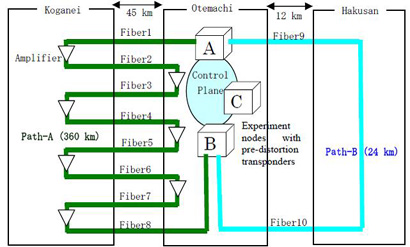
Fig. 1: Experiment Network Configuration
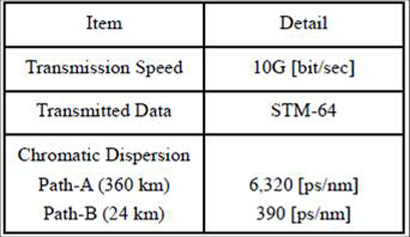
Tbl. 1: Details of the Established Paths
In this experiment, wavelength paths of different distances, Path-A and Path-B, had been successfully established between the same pair of transponders dynamically in less than two seconds and data transfer over the paths was confirmed. The details of the established paths are shown in Table 1.
We believe this is the first of such experiments applying GMPLS-based control to dynamic tuning of compensation-capable transponders for establishment of dynamic optical paths over real-field fibers.
Reference
1. Y. Lee et al., “A Framework for the Control of Wavelength Switched Optical Networks (WSON) with Impairments,” work in progress:
draft-ietf-ccamp-wson-impairments-01.txt, IETF, Oct. 2009.
2. S. Yoshida et al., “Design and Implementation of Chromatic Dispersion Control Protocol,” OECC 2009, ThN1, July, 2009.
3. K. Onohara et al., “Online Measurement of Chromatic Dispersion using Optical Supervisory Channels for Electronic Pre-Distortion,”
APCC/COIN2008, Oct. 2008.
4. E. Horiuchi et al., “Chromatic Dispersion Compensation Control in Dynamically Reconfigurable All-Optical Networks,” iPOP 2008, June 2008.
Biography: Shoichiro Seno is currently a head researcher at Information Technology R&D Center, Mitsubishi Electric Corporation, Japan. He received his B.S. and M.S. degrees from Tokyo Institute of Technology and his Ph.D. from Aichi Prefectural University. Since joining Mitsubishi Electric Corporation in 1983, he has been engaged in R&D of LAN internetworking, high-speed protocol processing, multi-protocol router, network security, and optical network technologies including GMPLS and ROADM.
3-3
"WSON Signal Characteristics and Network Element Compatibility Constraints for GMPLS Routing and Signaling and PCE"
Young Lee, Greg Bernstein, Huawei, USA
 Network element signal compatibility constraints and network element processing capabilities
have been identified as essential routing constraints in computing optical light-path in both transparent
and translucent optical networks characterized by common optical or hybrid electro optical systems such
as OEO switches, regenerators, and wavelength converters. This paper discusses GMPLS signaling and
routing enhancements to control these devices and PCEP enhancement to enable optical light-path
computation subject to network element compatibility constraints.
Network element signal compatibility constraints and network element processing capabilities
have been identified as essential routing constraints in computing optical light-path in both transparent
and translucent optical networks characterized by common optical or hybrid electro optical systems such
as OEO switches, regenerators, and wavelength converters. This paper discusses GMPLS signaling and
routing enhancements to control these devices and PCEP enhancement to enable optical light-path
computation subject to network element compatibility constraints.
While the current GMPLS WSON framework can deal with many types of wavelength switching systems there is a desire to extend the control plane to networks that include a combination of transparent optical and hybrid electro optical systems such as OEO switches, regenerators, and wavelength converters. Such networks are frequently referred to as translucent optical networks in the literature. Some of the systems use in such networks can be limited to processing WSON signals with specific characteristics or attributes. In addition, some of the network elements may be able to perform important optional processing functions such as regeneration or wavelength conversion on a signal and would need to be provisioned as part of optical path establishment.
This document discusses a WSON signal definition and attributes characterization based on ITU-T interface and signal class standards and describes the signal compatibility constraints of this extended set of network elements. The signal characterization, network element compatibility constraints and enhanced provisioning support enable GMPLS routing and signaling to control these devices and PCE to compute optical light-paths subject to signal compatibility attributes.
We proposed to call the signal that we will be working with an optical tributary signal like that defined in ITU-T G.698.1 and .2. This is an "entity" that can be put on an optical communications channel formed from links and network elements in a WSON. An optical tributary signal has the following attributes:
1. Optical tributary signal class: This relates to the specifics of modulation format, and bit rate
range.
2. FEC: Indicates whether forward error correction is used in the digital stream. This can possibly
change along a signal path if regenerators or similar elements are encountered.
3. Bit rate. This typically would not change since we are not changing the digital bit stream in any
end-to-end meaningful way.
4. Center frequency (wavelength). Can change along path if there are wavelength converters. This is
already modeled via labels in GMPLS.
5. G-PID: General Protocol Identifier for the information format. This would not change since this
describes the encoded bit stream. This is already present in GMPLS signaling. A set of G-PID
values are already defined for lambda switching in [RFC3471], [RFC4328].
GMPLS Signaling extensions are necessary in WSON under a number of conditions including: (a) when optional processing, such as regeneration, must be configured to occur at specific nodes along a path, (b) where equipment must be configured to accept an optical signal with specific attributes, or (c) where equipment must be configured to output an optical signal with specific attributes. One way of accomplishing this is via a new EXPLICIT_ROUTE subobject in ERO that conveys these attributes.
GMPLS Routing extensions are necessary in WSON to advertise Node constraints on Modulation type, FEC type, and processing capability (e.g., regeneration). PCEP extensions are also necessary to enable constrained-based optical light-path computation subject to these attributes and capabilities.
Biography: Young is currently Principal Technologist at Advance Technology Division, Huawei Technologies USA Research Center, Plano, Texas. He is leading WSON optical transport control plane technology research and development. His research interest includes distributed path computation architecture, multi-layer traffic engineering methodology, and network optimization modeling and new concept development in optical control plane signaling and routing.
Prior to joining to Huawei Technologies, Young was a co-founder and a Principal Architect at Ceterus Networks (2001-2005) where he developed topology discovery protocol and control plane architecture for optical transport core product. Prior to joining to Ceterus Networks, Young was Principal Technical Staff Member at AT&T/Bell Labs in Middletown/Holmdel, New Jersey. At AT&T Labs (1996-2000), he was responsible for core IP/MPLS network architecture evolution and AT&T End-to-end architecture planning. He also involved voice/data convergence architecture planning and evolution. At Bell Labs (1987-1995), Young was responsible for developing dynamic routing schemes and traffic network management control and measurement development. He is currently active in IETF PCE and CCAMP WGs and is a co-author of RFC 3214, RFC 5541and RFC 5557. He holds several patents in the area of dynamic routing and switching technology and several patents pending in optical networking.
Young Lee received B.A. degree in Applied Mathematics from the University of California at Berkeley in 1986, M.S. degree in Operations Research from Stanford University, Stanford, CA, in 1987, and Ph.D. degree in Decision Sciences and Engineering Systems from Rensselaer Polytechnic Institute, Troy, NY, in 1996.
Giulio Bottari, Diego Caviglia, Ericsson, Italy

 The Wavelength Switched Optical Networks (WSON) is one of major activities in IETF research and discussion: the intelligent control technology of WDM network has gradually matured and improved relative standards and technologies to find a commercial application. Main goals of the WSON work is reduce the cost of the network sharing resources and speed up the provisioning time. This new paradigm in optical networks imposes new challenges to both the network dimensioning and the wavelength provisioning.
The Wavelength Switched Optical Networks (WSON) is one of major activities in IETF research and discussion: the intelligent control technology of WDM network has gradually matured and improved relative standards and technologies to find a commercial application. Main goals of the WSON work is reduce the cost of the network sharing resources and speed up the provisioning time. This new paradigm in optical networks imposes new challenges to both the network dimensioning and the wavelength provisioning.
In this presentation we’ll illustrate a new architecture for a WSON based on the splitting of the path computation function in two Path Computation Elements (PCE). The first, called PCE+, operates in a planning tool while the second, called PCE- operates in the network management element. The two PCEs have different roles, but both leverages on the same, fast, way to assess the feasibility of the optical paths under computation.
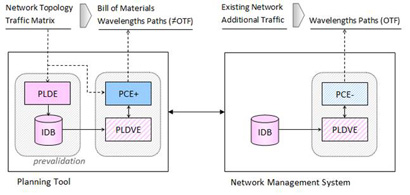
The Planning Tool:
- Contains a Photonic Link Design Engine (PLDE): a software module which assesses the physical layer;
- Perform the network prevalidation for the traffic types that will be involved in routing and, as a consequence, fill the Impairments Data Base (IDB) with the physical parameters;
- Setup a Photonic Link Design Virtual Engine (PLDVE) for the current network according to the above described process. The PLDVE concept has been presented in [1];
- Cointains the PCE+ engine which is able to calculate pre-planned, off-line, wavelength paths and to performs the resource allocation (including regenerators) using an impairments aware RWA with leverages on the PLDVE;
- Optionally, perform a final feasibility verification on the routed paths using the PLDE;
- On the basis of the PCE+ output, the Bill Of Material (BOM) is produced.
The Network Management System (NMS) performs the following tasks:
- Receive a copy of the IDB from the Planning Tool and it’s able to setup a PLDVE, which is a clone of the PLDVE contained in the Planning Tool: from now on the NMS can assess the feasibility of lightpath exactly as the Planning Tool;
- Contains the PCE- engine which is able to calculare on the fly, on-line, wavelengh paths using the existing network resources. The paths are physically assessed using the cloned PLDVE.
The introduction of the PLDVE method dramatically reduces the computation time and the amount of resources needed (CPU, Memory) and allows a fast lambda feasibility assessment in complex and dynamic network.
[1] - G.Bottari, D.Caviglia “Concurrent Impairments Aware Routing and Regenerator Location (PCE+) in a Wavelength Switched Optical Networks (WSON)” - IPOP09
Biography: Giulio Bottari is a senior system engineer at Ericsson. He joined the former Marconi in 1999. His research interests include: GMPLS based network control, path computation and impairments effects in WSONs. He is author of several publications and patents in the field of control plane and WDM systems.
Diego Caviglia is working in the standardization arena since beginning of 2000, he's been active in IETF and OIF. He's co-author of several IETF Internet-Drafts and some RFCs, for the OIF he's been the technical contact point for OIF Interoperability events. Diego, with respect the standardization activity, is toady working on WSON and MPLS-TP topic.
Diego has been the technical lead for the Marconi/Ericsson GMSPL project today as Ericsson employee Diego has the responsibility as Product Manager for the High Order SDH product family, the planning tools and the Optical Core Solution.
Technical Session
Tech. Session 4: PCE and Applications (II)
Friday 11, June 2010 15:05-16:45
Chair: Young Lee, Huawei, USA
Daniel King, Quintin Zhao, Old Dog Consulting, UK
The evolution of Automatically Switched Optical Network (ASON) is in response to the challenges and requirements for operating today's optical networks. The ITU-T developed ASON provides the architecture to automate the connection and management of services within the network. The IETF developed GMPLS is a set of protocols that can be used to communicate between network elements and setup services. ASON networks can be segmented into domains, subnetworks or routing areas that share common switching technologies, addressing schemes or management responsibility.
Computing and setting up end-to-end paths for services that traverse multiple optical domains pose a number of problems for the operator. The IETF PCE architecture and functional components present a solution for computing paths across multi-domain optical environments.
Within the ASON architecture, a PCE can be regarded as a realization of the ASON Route Controller (RC). Recent IETF PCE developments allow a hierarchical PCE mechanism to be applied and to fully satisfy the ASON routing architecture and requirements for remote route query (G-7715-2). The hierarchical PCE mechanism can be applied to ASON to determine optimal multi-domain end-to-end paths and improve the efficiency of connection setup.
This presentation will explore how the ITU-T ASON architectures (G-8080 and G-7715) and IETF GMPLS (OSPF-TE and RSVP-TE) and PCE (PCEP and H-PCE) technologies can be combined to provide constrained connections that cross multiple optical domains. We propose the architecture and outline the roles and responsibilities for the various ITU-T and IETF technologies. We demonstrate how a service request can be automated within the framework and the benefits of using the PCEenabled ASON. We conclude with an update and status of ASON related PCE standards work.
Biography:
Daniel King is an active editor, author and contributor within the IETF's PCE, MPLS and CCAMP working groups and is an editor or author on a number of IETF Internet-Drafts and RFCs related to path computation and network optimization. Daniel is secretary of three IETF working groups, namely PCE, CCAMP and L3VPN. Daniel has wide experience of packet and optical networks, having worked at a variety of vendors, and he was a founder of path computation specialists Aria Networks. He is now a senior consultant with Old Dog Consulting.
Quintin Zhao is a principal engineer at Huawei Technology. His main work is focused on PCE related protocols and architectures. Quintin currently leads the PCE P2MP technology projects within Huawei. His team is also responsible for standardization and product implementation efforts. He joined Huawei Technology in 2006 and before that he worked in Cisco System from 1999 to 2006 within the MPLS technology group. Prior to Cisco, he worked at Ericsson from 1996 to 1999 focused on VOIP technology. He obtained his B.S degree from Beijing Institute of Technology and MS degree in Computer Science from Iowa State University.
Zafar Ali, Tarek Saad, Cisco, USA
 The ability to compute constrained Traffic Engineering Label Switched Paths (TE LSPs) for point-to-multipoint (P2MP) LSPs in Multiprotocol Label Switching (MPLS) and Generalized MPLS (GMPLS) networks across multiple domains (where a domain is a collection of network elements within a common sphere of address management or path computational responsibility such as an IGP area or an Autonomous Systems) has been identified as a key requirement. This presentation outlines a PCE based path computation method to find remerge free and better route for a P2MP LSP. Specifically, it addresses this requirement by extending backward recursive path computation (BRPC) technique proposed for Point-to-Point (P2P) LSPs in for P2MP LSP path computation in a multiple domains network.
The ability to compute constrained Traffic Engineering Label Switched Paths (TE LSPs) for point-to-multipoint (P2MP) LSPs in Multiprotocol Label Switching (MPLS) and Generalized MPLS (GMPLS) networks across multiple domains (where a domain is a collection of network elements within a common sphere of address management or path computational responsibility such as an IGP area or an Autonomous Systems) has been identified as a key requirement. This presentation outlines a PCE based path computation method to find remerge free and better route for a P2MP LSP. Specifically, it addresses this requirement by extending backward recursive path computation (BRPC) technique proposed for Point-to-Point (P2P) LSPs in for P2MP LSP path computation in a multiple domains network.
Proposed outline for this presentation is as follows-
- Path Computation Requirements for P2MP LSP in a multi-domain environment.
- An overview of Backward-Recursive PCE-Based Computation (BRPC) procedure for P2P LSPs.
- Challenges in computing a path for P2MP LSP in a multi-domain environment.
- How BRPC technique is extended to address these requirements and challenges.
- Conclusion.
Biography: Zafar Ali is a Senior Technical Leader at Cisco Systems, Inc. where he leads software protocol development in Cisco Systems service provider routing group. Most recently Zafar has been focused on designing and developing label switch multicast protocols and solutions. Prior to joining Cisco, Zafar worked at Nortel Networks and Hughes Network Systems. Overall he has over 15 years of industry experience.
Zafar Ali is quite active as a member of the MPLS, CCAMP, BFD, IDR, RTG and other working group within IETF. He has authored a number of RFCs and IETF drafts. In addition, Zafar Ali has also authored several Journal papers, conference publications, white papers, patents, and book chapters. He is a regular presenter at MPLS conferences.
Zafar Ali received his Ph. D. and MS in Electrical and Computer Engineering from Purdue University, West Lafayette, Indiana. He obtained his Bachelor of Engineering in Electrical Engineering from NED University, Karachi, Pakistan where he was awarded the University Gold Medal.
Jonathan Sadler, Tellabs, USA
 In a network of large scale using mixed modulation schemes and mixed fiber types, selecting when OEO regeneration should be invoked is a challenge. For modulation schemes using lower symbol/baud rates, the distance the signal may travel before being overcome by physical impairments is longer than for modulation schemes using higher symbol rates. The use of different fiber types in the network complicates this problem. And as new digital signals beyond ODU1, 2, 3 are standardized for being carried over the optical network, the complexity is further increased.
In a network of large scale using mixed modulation schemes and mixed fiber types, selecting when OEO regeneration should be invoked is a challenge. For modulation schemes using lower symbol/baud rates, the distance the signal may travel before being overcome by physical impairments is longer than for modulation schemes using higher symbol rates. The use of different fiber types in the network complicates this problem. And as new digital signals beyond ODU1, 2, 3 are standardized for being carried over the optical network, the complexity is further increased.
This presentation will discuss three approaches to handle the selection of when to invoke regeneration. It will present a novel new way to perform path computation that finds the least cost path while taking into account the optical characteristics of a path and the location of pre-placed OEO regenerators. This method is able handle mixed-fiber type networks and is able to determine when pre-placed OEO regenerators need to be invoked, and selects the correct regeneration modules for the digital signal being carried.
Biography: Jonathan Sadler is a Senior Product Planner in the Optical Network Group at Tellabs.
With over 20 years of data communications experience as a protocol implementer, network element designer, carrier network operations manager, and carrier network planner, Jonathan brings a broad set of knowledge and experiences to the design and analysis of carrier network technology. Currently, Jonathan is involved in the development of technologies providing the efficient transport of packet oriented services in Carrier Networks. Jonathan is the Chairman of the Optical Internetworking Forum's Architecture and Signaling Working Group and an active participant in the IETF and ITU.
Jonathan studied Computer Science at the University of Wisconsin - Madison.
Yongli Zhao, Jie Zhang, Yuefeng Ji, Beijing University of Posts and Telecommunications, China

With the exponential growth of bandwidth requirements of various services and rapid expansion of network scale, multi-layer network (MLN) and multi-region network (MRN) architecture is an inevitable trend for the future networks. All the network technologies are to be re-considered. IETF CCAMP Working Group keeps making progress on multi-layer and multi-region network requirements and related protocol extensions, and PCE Working Group keeps making progress on PCE related standards, which makes the PCE technology more and more mature for commercial implementation. In order to validate the performance of multi-layer and multi-region networks, a large scale multi-layer and multi-region network testbed with a novel PCE-based routing architecture is built in our lab, which contains more than 1000 GMPLS-based control nodes and tens of regions.
In this presentation, we will analyze some required extensions or updates for various network technologies, such as routing, signaling and survivability, in multi-layer and multi-region networks. A novel PCE-based routing architecture which contains two routing engines Group Engine (GE) and Unit Engine (UE) is proposed and described in detail. Especially some potential cooperation modes between GE and UE are analyzed, such as coexistence mode, security backup mode, policy-enabled mode, constraint-based mode, service-oriented mode, multi-layer and multi-region mode and so on.
Then, architecture of the large scale multi-layer and multi-region network testbed is introduced. Some typical experiments are conducted on the testbed, which includes performance validation of some cooperation modes described above. Moreover, three typical routing schemes including hierarchical routing, PCE-based per-domain routing and backward recursive PCE-based path computation (BRPC) are conducted on the testbed and compared with our proposed novel PCE-based routing scheme.
At last, a dual-end recursive PCE-based computation procedure (DRPC) is proposed to compute shortest constrained inter-domain traffic engineering label switched paths. Path computation is launched at the source PCE and the destination PCE simultaneously. Then two shortest path graphs are generated at the middle PCE, which are stitched into a shortest path directional graph last. Therefore, the end-to-end constrained inter-domain traffic engineering label switched path, even the k shortest paths can be gained from the shortest path directional graph directly.
Biography: Yongli Zhao, PH.D, in Key Laboratory of Information Photonics and Optical Communications, Ministry of Education, Beijing University of Posts and Telecommunications. He has led or participated in more than ten national and company projects since 2005. He is always active in IETF working group, ITU-T and China Communications Standards Association (CCSA). He has published more than 20 papers indexed by SCI or EI. His work currently focuses on the GMPLS control plane, MLN/MRN, PCE and particularly the control and management technologies for photonic networks.
Technical Session
Tech. Session 5: Packet Transport over Optical
Friday 11, June 2010 17:00-18:15
Chair: Satoru Okamoto, Keio University, Japan
Shinya Ishida, Itaru Nishioka, Soichiro Araki, NEC, Japan
 SPs (Service Providers) have required cost effective networking solutions to accommodate significant growth of traffic
with emerging 100Gbps transmission systems. IP over WDM network is not always a good solution to transport IP
traffic in terms of network cost (i.e., CapEx). In IP over WDM networks, the IP layer is responsible for switching and
grooming traffic. This results in the increase of router degrees (i.e., the number of ports) and requires for each router to
have as many line cards as its degree. Generally, router line cards at 100Gbps will be expensive and power-consuming.
For this reason, SPs expect to reduce the number of router line cards to reduce the total cost of their networks. One
possible solution is to insert another layer between the IP and the WDM layer. This middle layer switches and grooms
traffic instead of the IP layer. Traffic switched in the middle layer bypasses ports of transit routers. Thus, line cards of
transit routers can be reduced. In addition, the middle layer must be offered with reasonable cost compared with the IP
layer. This is because the middle layer itself becomes an additional cost factor while it reduces the cost of the IP layer.
Therefore, the amount of cost reduction by the middle layer must excess the amount of cost increase.
SPs (Service Providers) have required cost effective networking solutions to accommodate significant growth of traffic
with emerging 100Gbps transmission systems. IP over WDM network is not always a good solution to transport IP
traffic in terms of network cost (i.e., CapEx). In IP over WDM networks, the IP layer is responsible for switching and
grooming traffic. This results in the increase of router degrees (i.e., the number of ports) and requires for each router to
have as many line cards as its degree. Generally, router line cards at 100Gbps will be expensive and power-consuming.
For this reason, SPs expect to reduce the number of router line cards to reduce the total cost of their networks. One
possible solution is to insert another layer between the IP and the WDM layer. This middle layer switches and grooms
traffic instead of the IP layer. Traffic switched in the middle layer bypasses ports of transit routers. Thus, line cards of
transit routers can be reduced. In addition, the middle layer must be offered with reasonable cost compared with the IP
layer. This is because the middle layer itself becomes an additional cost factor while it reduces the cost of the IP layer.
Therefore, the amount of cost reduction by the middle layer must excess the amount of cost increase.
One of such middle layers is OTN (Optical Transport Network) [1]. It has been shown that OTN may provide about 10 - 40 percent more cost-effective solutions to transport IP traffic than IP over WDM networks does [2]. While OTN is a circuit switching technology, it supports various sub-wavelength bandwidth granularities; ODU0 for 1.25Gbps to ODU4 for 100Gbps, and ODUflex for arbitrary traffic rate. IP links with sub-wavelength bandwidth are mapped to appropriate ODUk paths and multiplexed in a wavelength. This function decreases the number of wavelengths required in the WDM layer. Line cards of optical transport networks are typically about one-third as expensive as router line cards [2]. The increased cost by OTN switches and line cards is still less than the decreased cost of router line cards.
Another possible middle layer is PTN (Packet Transport Network) using packet transport technologies, such as MPLSTP [3], which are also capable of switching and grooming traffic. One of attractive characteristics of PTN is the flexibility of bandwidth usage. A path in PTN may take any arbitrary bandwidth, from zero to the link capacity, as much as the amount of traffic to be transported. It is predictable that OTN also achieves almost the equivalent resource utilization as PTN using ODUflex with TS=1.25Gbps especially when designing core networks. However, including failure recovery, PTN may outperform OTN in terms of the efficient resource usage. Bandwidth can be sharable among working and backup/restoration paths in PTN while typical OTN may adopt either 1+1 or M:N protection, which requires timeslots not used by working paths. Therefore, it is still worth comparing IP over PTN over WDM with IP over OTN over WDM architectures even if line cards of PTN is somewhat more expensive than those of OTN.
However, it is not easy to minimize the total cost by the three-layer architecture. Network planners must find minimum sets of equipments to be installed in the middle layer to maximize the amount of cost reduction. They also need to satisfy the network performance, such as network capacity, latency, and reliability, which is requested by their customers or specified by their network operation policies. In addition, layer specific constraints may have to be taken into account; e.g., the acceptable packet traffic rate against link capacity, timeslot position, the wavelength continuity constraint, and the transmissible distance of optical signal. Therefore, a network planning scheme to solve such complicated constraints is mandatory to find optimal multi-layer networking solutions.
In this presentation, we investigate which is the most cost-effective way to transport IP traffic among architectures using OTN, PTN, both of them, and without them. We will provide comprehensive case studies with numerical evaluation using a 46-site US backbone network topology. We evaluate the costs and resource utilization of the four architectures by our network planning tool as changing the amount and the distribution of IP traffic. For the OTN layer, we also examine the effect of the capabilities of ODU0 and ODUflex.
[1] ITU-T Recommendation G.709/Y.1331, “Interfaces for the Optical Transport Network (OTN),” December 2009.
[2] S. Sengupta, et. al., “Switched optical backbone for cost-effective scalable core IP networks,”
IEEE Communications Magazine, vol. 41, no. 6, June 2003.
[3] M. Bocci, et. al., “A Framework for MPLS in Transport Networks,” IETF draft-ietf-mpls-tp-framework-10.txt,
February 2010.
Biography: Shinya Ishida received his M.E. and Ph.D. degrees in Information Science and Technology from Osaka University, Osaka, Japan, in 2004 and 2007, respectively. Currently He is a researcher at System Platforms Research Laboratories, NEC Corporation, Japan. His research interests include architecture of packet/optical transport networks and related topics.
Kenji Fujikawa, Hideki Otsuki, NICT, Japan
 All optical networks employing wavelength-division multiplexing
(WDM) considered to be promising solutions for the future networking.
Over the all optical WDM networks, using Optical Circuit
Switches (OCS), an optical path (wavelength path) is reserved and
established between two end nodes, and is able to provide end users
with guaranteed communication.
All optical networks employing wavelength-division multiplexing
(WDM) considered to be promising solutions for the future networking.
Over the all optical WDM networks, using Optical Circuit
Switches (OCS), an optical path (wavelength path) is reserved and
established between two end nodes, and is able to provide end users
with guaranteed communication.
Currently, OSPF-TE and RSVP-TE are proposed and being implemented as routing and signaling protocols for constructing optical paths. However, their objectives are focused on traffic engineering, that is, they construct optical paths between routers, not between end hosts, in order to achieve load balancing, failure recovery and etc.
We are promoting a new-generation network design project called as AKARI project, where integration of optical packet and path is one of the main themes. In the optical-path/packet-integrated network, best-effort data and control data is delivered by optical packets, and QoS-guaranteed and multicast data are delivered by end-to-end optical paths.
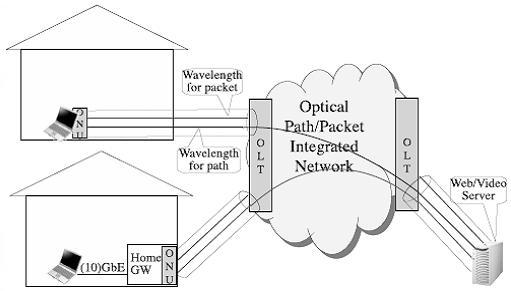
Fig. 1: Usage of end-to-end optical paths
Let us consider the usage of end-to-end optical paths in the future (Fig. 1). Optical fibers are directly connected to PC’s or Home Gateways (HomeGW’s) equipped with an ONU in homes and offices. PC’s and HomeGW’s send and receive multiple wavelength by themselves, and use multiple wavelengths separately, some for optical packets and the others for optical paths. Similarly, web/video servers use multiple wavelengths separately.
Fig. 2 shows a system in considering applications on end hosts make use of optical paths.
Provided that an end host conforms to UNIX, in general, an application calls the socket API (such as socket/listen/connect/accept system calls) so that establishes a Layer 4 (L4) connection, and communicates with the other end application.

Fig. 2: An end-to-end optical-path/packet-integrated system
We propose and implement a method that extends the socket API so that assigns an optical path to an L4 connection, and enables end users to use end-to-end optical paths.
In our proposed system, an application obtains a file descriptor with the socket() system call, and makes a requests for the kernel to assign an optical path to the L4 connection with the extended setsockopt() system call. The kernel notifies a signaling daemon (such as RSVPd) of the request by upcall, and then the signaling daemon exchanges signaling messages with daemons in the other end and enroute routers, and establishes an end-to-end optical path (wavelength path).
The kernel and signaling daemon in the end host cooperates with each other, and the kernel assigns the optical path established by the signaling daemon to the L4 connection established by the application. Then, data packets are exchanged on the established optical path. Note that control packets for signaling are exchanged on a wavelength for packets.
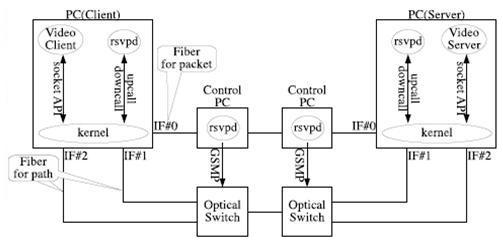
Fig. 3: An end-to-end optical-path system for developing/verifying end hosts
We modified and extended the socket API of Linux (CentOS 4.6) according to the proposed method, configured a system shown in Fig. 3, and verified the system.
Our proposed system achieves to provide end users with end-to-end QoS-guaranteed optical paths.
Biography: Kenji Fujikawa was born in 1970.Received BE, ME and PhD in the field of Information Science from Kyoto University in 1993, 1995, and 2000, respectively.
From 1997 he was a research associate of Graduate School of Informatics in Kyoto University.
From 2006 he was a chief researcher in Root Inc.
From 2008 he is an expert researcher of New-Generation Network Research Center in NICT. His research interest includes QoS-guarantee, multicasting, mobility on the Internet, and New-Generation Network.
Takumi Oishi, Hideki Endo, Kenichi Sakamoto, Hitachi, Japan
 Introduction
Node Architecture for High Service Availability in Packet Transport Networks
Packet transport networks must provide as high service availability as legacy transport networks do to replace them with packet transport networks. To realize this, a requirement and node architecture of packet transport are investigated. After this, we are developing packet transport node which is capable of MPLS-TP. Because MPLS-TP has been currently standardized at IETF, OAM (Operation, Administration and Maintenance) functions are being developed according to the draft documents.
Introduction
Node Architecture for High Service Availability in Packet Transport Networks
Packet transport networks must provide as high service availability as legacy transport networks do to replace them with packet transport networks. To realize this, a requirement and node architecture of packet transport are investigated. After this, we are developing packet transport node which is capable of MPLS-TP. Because MPLS-TP has been currently standardized at IETF, OAM (Operation, Administration and Maintenance) functions are being developed according to the draft documents.
Requirement to packet transport networks The service availability is defined as the proportion of service continuity period to a certain period such as a month or a year. Legacy services such as public telephone and leased line require more than 99.9% of service availability in legacy transport networks. Hence the requirement to packet transport networks is that service availability should be more than 99.9%. Usually, end-to-end path protection (APS, automatic protection switching) and interface redundancy are deployed to increase the service availability, and path protection is activated by the OAM functions. Therefore, the key point is interworking architecture of OAM functions, APS, and interface redundancy.
Issues and proposed solution considering implementation To meet the requirement, there are issues to be solved such as trade-off of implementing OAM functions by hardware or software in terms of performance, and trade-off between bandwidth consumption and APS performance. Basically functions which are required high performance should be implemented by hardware. For example, connection verification (CV) and continuity check (CC). Other function can be implemented by software. And bandwidth consumption by OAM frames is another issue. For fast APS, shorter interval between CC/CV frames is better. But, shorter interval means more bandwidth consumption by CC/CV frames. Considering these issues, node architecture for high service availability is proposed.
Conclusion A requirement is investigated to realize as high service availability in packet transport networks as in legacy transport networks. If this requirement is achieved, packet transport networks can replace legacy transport networks in terms of service availability. And key issues are derived from the requirement. By discussing these issues, node architecture for high service availability in packet transport networks is proposed. According to this architecture, we are developing a packet transport node and, it will be investigated in future whether 99.9% of service availability can be achieved or not.
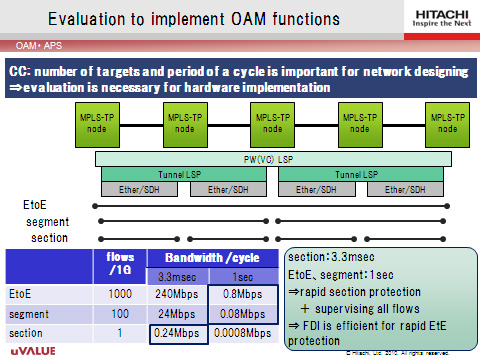
Fig. 1: Architecture of path protection and CC/CVs
Biography: Takumi Oishi, Senior Researcher, Central Research Laboratory of Hitachi, Ltd. He joined Hitachi in 1998, and he is interested in the area of network architecture and network node architecture. He received the B.E., M.E. degrees in electrical engineering from Kyoto University, Kyoto Japan, in 1996 and 1998 respectively.
Closing Remarks
Friday 11, June 2010 18:15-18:30
Atsushi Hiramatsu, Organization Committee Chair, NTT, Japan